
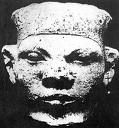
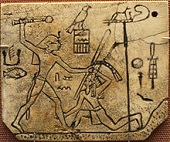
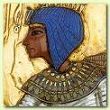

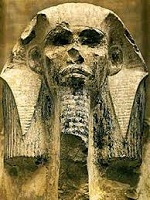
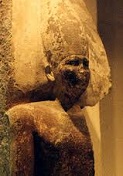
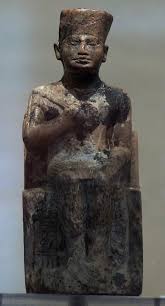
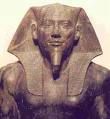


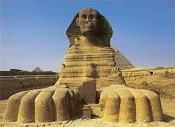
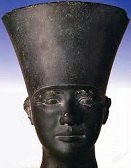


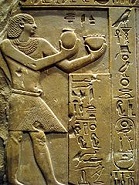




















TLW's Ancient Egyptscope™ (Ancient Egypt Historyscope) |
By T.L. Winslow (TLW), the Historyscoper™ |
© Copyright by T.L. Winslow. All Rights Reserved. |
Original Pub. Date: Mar. 8, 2016. Last Update: Sept. 14, 2024. |

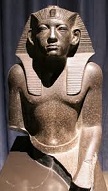


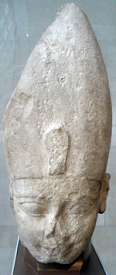



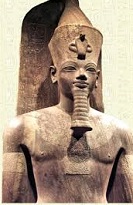











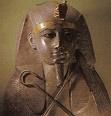
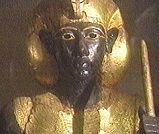
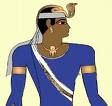

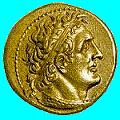
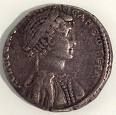

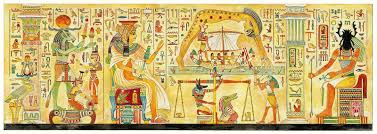
Westerners are not only known as history ignoramuses, but double dumbass history ignoramuses when it comes to ancient Egyptian history/a>. Since I'm the one-and-only Historyscoper (tm), let me quickly bring you up to speed before you dive into my Master Historyscope.
In 5,316 B.C.E. an Egyptian city in Sohag, Egypt 400m from King Seti I's temple in Abydos is the oldest known from the Egyptian First Dynasty.
About 5,200 B.C.E. the Predynastic (Prehistoric) Period (Zeroth Dynasty) of Egypt begins (ends -3100); the Sahara Desert begins drying out (ends -4000), causing migration to the Nile Valley, where the earliest known agricultural settlement in Egypt is founded in the Faiyum Depression 50 mi. SW of Cairo, raising wheat, barley, sheep, goats and pigs; discovered in 2008.
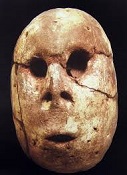
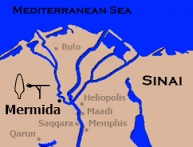
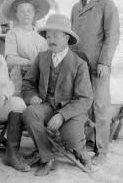
About 4,800-4,300 B.C.E. the Neolithic farming community of Merimda Beni-Salame, in the Western Nile Delta 35 mi. NW of modern-day Cairo is founded; they bury their dead inside their settlements and produce clay figurines incl. a lifesize head; discovered in 1928 by German archeologist Hermann Junker (1877-1962).
About 4,300 B.C.E. funerary textiles are made with the same ingredients used on mummies in 2,500 B.C.E.

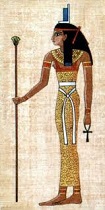


About 4,000 B.C.E. Ancient Egyptian religion begins, with a vast pantheon of gods who control the forces of Nature, requiring priests to propitiate them, and the pharaoh acting as intermediary between them and the people, causing enormous resources to be dedicated to rituals and temple construction; the Egyptian god Min is first worshipped as the god of reproduction, usually represented as a man holding his erect penis in one hand and a fail in the other - the original cracker? They also worshipped the mutter, er, mother goddess Mut (Maut) (Mout) AKA World Mother, Lady of Heaven, Mother of the Gods, Queen of the Goddesses, Eye of Ra, and She Who Gives Birth But Was Herself Not Born of Any; another early god worshipped by early Egyptians is the lunar deity Yah (Jah) (Iah) (Aah) ("Moon"), which is gradually assimilated into Osiris, god of the dead and Thoth, god of knowledge; origin of the Hebrew god Yahweh?; too bad for modern Christians, Jews, and Muslims, the ancient Egyptians happily lived and died and never worried about being saved by Christ, Moses, or Muhammad.
About 4,000 B.C.E. the Egyptians develop sailing vessels (feluccas) for use near the mouth of the Nile River, along with the Sundial, and Leavened Bread.

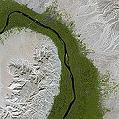

About 4,000 B.C.E. city-states begin to rise along the banks of the leisurely Euphrates River (Persian "ufratu" = good to cross over, Sumerian for fruitful) and swift Tigris River (Persian "tigra" = pointed, Sumerian "idigna" = swift river), and along the Nile River in Egypt; the Egyptians (Remetch, meaning "people") enjoy a lack of natural enemies, giving them the longest period of political stability in human history; the Nile is neat because it not only floods once a year and leaves a couple of miles of fertile silt on each bank, but it flows from S to N while the wind always blows from N to S because of the Mediterranean Sea, so that you can sail S and then turn around and float back N with the current.
About 4,000 B.C.E. the Amratian Culture (Naqada I) in Upper Egypt around El-Amra begins (until -3.5K), known for mud-brick bldgs., white cross-line pottery, and cosmetic palettes.
About 3,700 B.C.E. there is evidence of domesticated cats in Hierakonpolis, Egypt.
About 3,600 B.C.E. the first use of iron by Egptians is in making jewelry from meteorites at Gerzeh 40 mi. S of Cairo.
About 3,500 B.C.E. the Chalcolithic Period (begun -4.5K) ends, and the Early Bronze Period of archaeology begins (-3300?) (ends -2100), featuring the Jemdet Nasr Culture in Sumeria (-3100 to -2900), which incl. clay tablets with economic texts, the use of bronze, and extensive overseas trade; the ziggurat ("built on a raised area") stepped pyramidal mud brick tower with rectangular shrine on top, and cylinder seal (which can be rolled over a clay tablet to reveal a scene) are developed; Predynastic Egypt is stimulated by the Mesopotamian culture, and the cultures of Nubia and Egypt begin to diverge.
About 3,500 B.C.E. the Gerzeh (Girza) (Jirzah) (Naqada II) predynastic Egyptian culture along the W bank of the Nile River E of Al Fayyum begins (until -3.2K), known for pottery featuring stylized animals incl. ostriches, and large tombs.
About 3,500 B.C.E. the harp is first used in Sumer (Ur), along with the lyre, spreading to Egypt by 3000 B.C.E.
About 3,500 B.C.E. the village of Maadi ("the ferries") on the E bank of the Nile River 9 mi. S of modern-day Cairo is founded as a trade center at the end of the overland trade route to Palestine; in modern times it because a leafy upscale neighborhood popular with diplomats, and home of Cairo Am. College and the Egyptian supreme court, with no bridge across the Nile.
About 3,500 B.C.E. the first tall 4-sided narrow tapering Egyptian obelisks (tekhenu) (Gr. "obelos" = pointed pillar) are constructed, with a pyramidion on top; they represent Osiris' erect phallus?
About 3,400 B.C.E. the Gebelein predynastic mummies near Gebelein (modern-day Naga el-Gherira), Egypt are buried, and excavated in the 1890s C.E. by Wallis Budge of the British Museum; natural mummication caused by the hot Sun gave the Egyptians ideas, but it takes until -2600 for the Egyptians to practice true mummification.
By 3,300 B.C.E. Egypt is organized into the two kingdoms of Upper and Lower Egypt. The first Hieroglyphs appear on labels and pottery in Egypt, along with the first scrolls of Papyrus.
About 3,250 B.C.E. isolated Egypt begins trading with Mesopotamia, which influences them in architectural techniques, materials, and writing.

About 3,200 B.C.E. the Scorpion King I rules in Thinis in Upper Egypt, during which the Naqada III culture begins (until -3,150); meanwhile Scorpion King II (Selk or Weha?) rules in Nekhen in Upper Egypt - he's bragging?
About 3,200 B.C.E. Egyptians and Mesopotamians develop sail-powered boats.
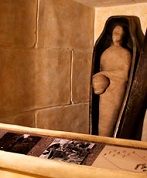

About 3,200 B.C.E. a child's grave in Egypt contains objects used for a crude form of bowling, as discovered in 1930 by Sir William Matthew Flanders Petrie (1853-1942).

About 3,150 B.C.E. King Narmer (Catfish) (AKA Menes) of the Thinite Confederacy becomes the first king to unite Upper and Lower Egypt, becoming the first to use the title of pharaoh ("great house"), founding the Egyptian First Dynasty (ends -2909), and the Early Dynastic Period (ends -2686), with capital at Thinis (This) (Tjenu) (near Abydos?); he goes on to build the city of Memphis at the apex of the Nile Delta in Lower Egypt, and improves and enlarges the site by constructing a dam to divert the Nile River, beginning the basin system of agriculture in the Nile Valley; Memphis becomes the center of worship of Ptah, the god of creation; the city of Sais on the upper W side of the Nile Delta is an important cult center; all the pharaohs of this dynasty have retainers sacrified and buried near their tombs, along with animals in Abydos (Abdju); in succeeding dynasties the humans are replaced by ushabtis (figurines); the earliest depiction of a sailboat (made of bundled papyrus reeds) dates to this dynasty - catfish beats scorpion?
About -3,125 the first wine discovered in Egypt in modern times is produced in Jordan and buried in the Scorpion King's tomb.
About 3,100 B.C.E. Narmer's son Aha (Hor-Aha) (Horus-Aha) becomes king #2 of the Egyptian First Dynasty, enjoying a long reign.
By 3,100 B.C.E. there are about 40 stable agricultural communities on the Nile, which always floods in Sept. and recedes by the end of Nov., and doesn't need ploughing or hoeing to produce crops. In 3,100 B.C.E. Hieratic script, a cursive form of hieroglypics written with a blunt reed pen on papyrus is invented in Egypt about this time, but doesn't become common for six cents. (-2500).
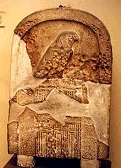
In 3,049 B.C.E. Djer becomes king #3 of the Egyptian First Dynasty, and rules 41 years; 338 people are buried with him.

In 3,008 B.C.E. Djet (Zet) (Wadj) (Euadji) ("Serpent of Horus") (Uenephes?) (Atothis?) becomes king #4 of the Egyptian First Dynasty (until -2998), carrying on intense trade with Syria and Palestine, incl. pottery.
About 3,000 B.C.E. irrigation is developed in Nubia (modern-day Sudan), using the flood waters of the Nile River with a waterwheel-like device called the sakia.
About 3,000 B.C.E. the first permanent copper shaving razors appear in Egypt and India.
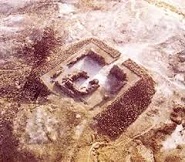

About 3,000 B.C.E. the Egyptians build two temples to ibis-headed Thoth ("he who is like the ibis") (god of wisdom and inventor of writing, the heart and tongue of Ra, whose curved beak represents the crescent Moon) on Thoth Hill in W Thebes; he is sometimes portrayed with a baboon head instead.

In 2,998 B.C.E. Djet dies, and his sister-wife Merneith (Meritneith) (Meryt-Neith) ("Beloved by Neith") becomes king #5 of the Egyptian First Dynasty as regent for their son Den, becoming the first female pharaoh of ancient Egypt.

In 2,970 B.C.E. Merneith's son Den (Hor-Den) (Denen) (Udimu) reaches the age of majority and becomes king #6 of the Egyptian First Dynasty, ruling 42 years (until -2928), becoming the first to use the title "King of Lower and Upper Egypt" and the first depicted wearing the red-white double crown, establishing many patterns of court ritual and royalty and being held in high esteem by his immediate successors; his tomb in Umm el-Qa'ab (near Abydos) has a red-black granite floor, becoming the first hard stone used as building material in Egypt. About this time unsealed wine jars are buried in Queen Merneith's tomb.
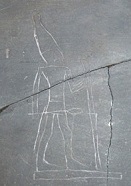
In 2,928 B.C.E. Den dies, and his son Anedjib (Hor-Anedjib) (Adjib) (Hor-Adjib) (Enezib) becomes king #7 of the Egyptian First Dynsty, ruling 10 years (until -2918).

In 2,918 B.C.E. Anedjib dies, and his son Smerkhet ("companion of the divine community") becomes king #8 of the Egyptian First Dynasty, ruling only 8.5 years (until -2909) after a great pestilence strikes his kingdom.

In 2,909 B.C.E. Semerkhet dies, and his son Qa'a (Ka'a) becomes king #9 (last) of the Egyptian First Dynasty, ruling for 33 years (until -2876); too bad, a dynastic war begins after his death, with Horus Bird and Sneferka fighting for power until Hot and Sexy wins.

In 2,890 B.C.E. Hotepsekhemwy ("the two powers are reconciled") becomes king #1 of the Egyptian Second Dynasty (ends -2672), with capital at Thinis (This) (Tjenu) (near Abydos) (modern-day Girga), going on to rule 29 years (until -2861).
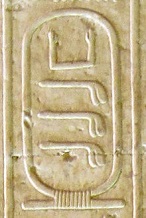
In 2,861 B.C.E. Nebra (Raneb) ("lord of the Sun of Horus") (Weneg?) becomes king #2 of the Egyptian Second Dynasty, reigning 14 years (until -2847).
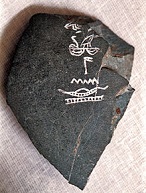
In 2,847 B.C.E. Nynetjer (Ninetjer) (Banetjer) becomes king #3 of the Egyptian Second Dynasty, reigning 45 years (until -2802).

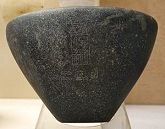
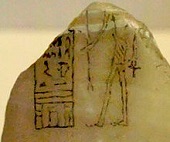

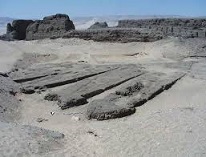
In 2,802 B.C.E. Senedj (Sened) (Sethenes) becomes king #4 of the Egyptian Second Dynsty, ruling unknown years, after which king #5 Seth-Peribsen (Perabsen) (Ash-Peribsen) and king #6 Sekhemib-Perenmaat (Sekhemib) rule for unknown years while the War between Seth and Horus (worshippers) rocks the nation, and Seth wins, after which in -2690 Khasekhemy (Kasekhemui) ("the two powerful ones appear") becomes king #7 (last) of the Egyptian Second Dynasty, ruling for 18 years (until -2672), leaving the 14 brick-enclosed plank-and-rope Abydos Boats (discovered in 2000 C.E.) along with the mud brick Shunet ez-Zebib funeral structure, marking the start of the Egyptian belief in the afterlife being a place to take their stuff and live forever?
About 2,700 B.C.E. the square-sailed ship is invented in Egypt.

In 2,686 B.C.E. Khasekhemwy (Khasekhemui) ("the two powerful ones appear") becomes king #5 of Egypt's Second Dynasty, uniting Upper and Lower Egypt.

In 2,670 B.C.E. the Egyptian Third Dynasty is founded after a civil war by Zanakht (Sanakhte) (Nebka) (d. -2630); the Old Kingdom (Age of the Pyramids) (3rd through 6th Dynasties) begins (ends -2200), worshiping the Ogdoad (Gr. "8-fold") of eight deities in Hermopolis, made of of four male-female pairs, with the males associated with frogs and the females with snakes, incl. Nu and Naunet, Amun and Amaunet, Kuk and Kauket, Huh and Hauhet.
Third time's the charm, as Pyramids take a great step forward without bulldjosers?

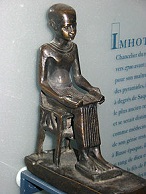
In 2,630 B.C.E. Zanakht dies, and his younger brother Djoser (Zoser) (Netjerykhet = "divine of body") (d. -2610) becomes king #2 of Egypt's Third Dynasty, ruling for 29 years, building the Step Pyramid in Saqqara 12 mi. S of modern-day Cairo, becoming the first pyramid in Egypt, launching the Age of the Pyramids (3rd thru 6th Dynasties, AKA the Old Kingdom) (ends -2200); Djoser's painted limestone statue in Saqqara becomes the oldest life-sized Egyptian statue to survive to modern times; chancellor Imhotep ("one who comes in peace"), architect of the Step Pyramid and high priest of Ra in Heliopolis thrives during the Third Dynasty at the court of King Djoser, later becoming the center of a cult in Memphis in the 30th Dynasty (380-343 B.C.E.), worshiped as the "god of medicine" and "prince of peace", becoming the only Egyptian commoner to be deified after his death other than Amenhotep, son of Hapu.

In 2,610 B.C.E. Djoser dies, and his son Sekhemkhet (Djoser Teti) becomes king #3 of Egypt's Third Dynasty, rulng for seven years.

In 2,603 B.C.E. Sekhemkht dies, and Khaba (d. -2599), becomes king #4 of Egypt's Third Dynasty, going on to build the Layer Pyramid 5 mi. SW of Giza.

In 2,599 B.C.E. Khaba dies, and Huni (d. -2575) becomes king #5 of Egypt's Third Dynasty; his wife is Meresankh I.


In 2,575 B.C.E. Huni dies, and his son Sneferu (Snefru) (Snofru) (d. -2551) becomes king #6 (last) of the Egyptian Third Dynasty, building the Pyramids of Dhashur in the royal necropolis of Dahshur (40 km S of Cairo) incl. the Red Pyramid and the Bent Pyramid, establishing commerce with Phoenicia.


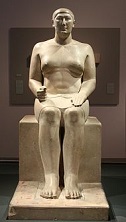
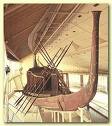


In 2,551 B.C.E. Sneferu dies (-2589?), and his son Khufu (Cheops) (d. -2528) becomes king #2 of the Egyptian Fourth Dynasty; his mother is Hetepheres (Hetapheres) I; Khufu builds the 450-ft.-high Great Pyramid of Khufu (Cheops) (Giza) at Al Jizah (Giza Plateau), 0.25 mi. W of the Nile River, becoming the tallest bldg. in the world until the 19th cent. C.E.; Pliny the Elder mentions it in his Natural History, saying that it is worshipped as a "divinity", and that "King Harmais was buried in it"; it incl. a tablet explaining how Thoth, god of the night gambled with the Moon and won five days to add to the 360-day calendar outside the jurisdiction of Sun god Ra; the architect is man-breasted Hemon (Hemiunu), son of Snefru and cousin of Khufu; the work takes 100K workers 20 years, and uses 3M 2.5-15-ton stone blocks from Giza, the E bank of the Nile, and Aswan (600 mi. downstream) (only source of granite in Egypt), impoverishing the country and using up the entire male pop.; in 1954 C.E. the 125-ft. Solar Funeral Barque (Ship) of Khufu is discovered near the Great Pyramid; it was really built between -5K and -7K, as proved by the water weathering on the limestone? - John Anthony West (1932-); it was really built on an island, and originally had a gigantic statue of Anubis the watchdog?; the water weathering came from Noah's Flood? :); in 2007 C.E. Jean-Pierre Houdin (1951-) claims to have discovered how they built it, using an outer ramp for the first 140 ft. and a corkscrew-shaped inner ramp for the next 310 ft.; in 2010 the existence of dried mud brick tombs nearby are claimed to prove that the workers were not slaves - gaining the whole world and losing his soul?


In -2,528 Khufu dies, and his son Djedefre (Djedefra) (Radjedef) (Ratoises) (d. -2520) becomes king #2 of Egypt's Fourth Dynasty, becoming the first to style himself Son of Ra; his wife is his sister Hetepheres II, mother of Meresankh II, who marries King Khafre.


In 2,520 B.C.E. Djedefre dies, and his brother Khephren (Khafre) (Khafre) (Chephren) (d. -2494) becomes king #3 of Egypt's Fourth Dynasty, going on to build the Great Sphinx of Giza and the Pyramid of Khafre (Second Pyramid of Giza).
About 2,500 B.C.E. the ox-drawn plow (ard) is invented in Egypt.
About 2,500 B.C.E. the first illustration of a cat with a collar is in a tomb in Saqqara, Egypt.
About 2,500 B.C.E. Lipstick is first is used by Sumerians in Mesopotamia, made of crushed gemstones; by -2000 women in the Indus Valley use dyes, and Egyptian women use crushed carmine beetles, with fish scales for a pearlescent effect; Cleopatra VII becomes a big fan.
About 2,500 B.C.E. the Egyptians begin the practice of producing foie gras by force-feeding geese and other birds.

In 2494 B.C.E. Khephren dies, and Bakare (Bikheris) (d. -2490) becomes king #4 of Egypt's Fourth Dynasty; the Egyptians begin sending ships to the Land of Punt (Pwene) (Pwenet) on the African coast of modern-day Eritrea and Somalia (which gets as close as 15 mi. to the coast of Arabia), collecting myrrh to go with the frankincense (olibanum) from the Dhofar (modern-day Oman) region of S Arabia (obtained from the resin of trees of the genus Boswellia) - oh man, that incense is frank?

In 2,490 B.C.E. Bakare dies, and Menkaura (Menkaure) (Menhaure) (Mycerinus) (d. -2472) becomes king #5 of Egypt's Fourth Dynasty, building the 3rd pyramid at Al Jizah (Giza); his main wife is Khamerernebty II; his other wife is Rekhetre.

In 2,472 B.C.E. Menkaura dies, and Shepseskaf (d. -2467) becomes king #6 (last?) of Egypt's Fourth Dynasty.
In 2,467 B.C.E. Shepseskaf dies, and (imaginary?) Thamphthis (Djedefptah) (d. -2465) becomes king #7 (last?) of the Egyptian Fourth Dynasty.

In 2,465 B.C.E. Thamphthis dies, and Userkaf ("His ka or soul is powerful") (d. -2458) (r. -2494 to -2487?) becomes king #1 of the Egyptian Fifth Dynasty, starting the tradition of building Sun temples in Abusir ("House of Osiris"); his wife is Khentkaues; he builds the Pyramid of Userkaf in Saqqara S of modern-day Cairo; in 2006 after arrested tomb robbers lead archaeologists to the graves, royal dentists Iy Mry, Kem Msw, and Sekhem Ka are discovered near the Step Pyramid of Djoser, complete with a warning that anyone violating the grave will be eaten by a crocodle and a snake; the first mention of the god Osiros (Asiri) (Ausar) (Ausir), "Foremost of the Westerners" (Khenti-Amentiu), "King of the Living", "Lord of the Dead" "Lord of Love", "Ever-Benign and Youthful", "Lord of Silence" (son of Ra and Nut, brother-husband of Isis, brother of Set, Nephthys, and Horus the Elder, and posth. father of Horus the the Younger) (known for rising from the dead) is made in the middle of this dynasty, becoming associated with the heliacal rising of Orion and Sirius during the new year, with pharaohs and later all Egyptians seeking eternal life through him; his main symbol is the 4-banded Djed ("pillar"), representing his spine.

In 2,458 B.C.E. Userkaf dies, and his son (by Neferhetepes) Sahure (Sahureh) ("He who is close to Ra") (d. -2446) becomes king #2 of Egypt's Fifth Dynasty, going on to establish trade relations with the Levantine coast, sending several naval expeditions to Lebanon to procure cedars, slaves, etc., to the land of Punt to procure myrrh, malachite, and electrum, and to Sinai to procure copper and turquoise, and building the Pyramid of Sahure in Abusir, which introduces the palm leaf capital, adorned by 110K sq. ft. of fine reliefs; he becomes the only pharoah to be shown in a relief doing gardening work (tending a myrrh tree).
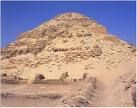
In 2,446 B.C.E. Sahure dies, and his son Neferirkare (Neferirkara) Kakai ("Beautiful is the soul of Ra") (d. -2426) becomes king #3 of the Egyptian Fifth Dynasty, becoming known for his kind and gentle rule, incl. pardoning elderly royal hairdresser Rawer for accidentally touching his mace during a religious ceremony; his wife is Khentkaus II.
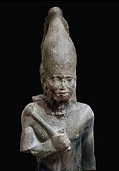
In 2,426 Neferirkare Kakai dies, and his son Neferefre (Raneferef) ("Beautiful is Ra") (d. -2424) becomes king #4 of the Egyptian Fifth Dynasty, ruling only 2-3 years, leaving an unfinished pyramid in Abusir; his wife is Khentkaus (Khentakawess) III.

In 2,424 B.C.E. Neferefre dies, and Sahure's son Shakespeare, er, Shepseskare (Shepseskara) Isi (Sisiris) ("Noble of the throne of Ra") (d. -2424) becomes king #5 of the Egyptian Fifth Dynasty, reigning only a few mo. and leaving an unfinished pyramid in Abusir.
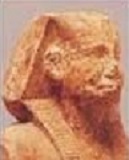
In 2,416 B.C.E. Shepseskare dies, and Neferirkare Kakai's youngest son (by Khentkaus II) (brother of Neferefre) Nyuserra (Nyuserre) (Neuserre) ("Possessed of Ra's power") Ini (d. -2392) becomes king #6 of the Egyptian Fifth Dynasty.
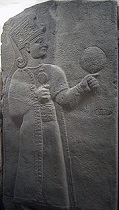


About 2,400 B.C.E. tavern keeper Kubaba (Ku-Bau) (Kug-Bau) becomes queen of Kish, becoming the only woman to rule in Sumer and Akkad, reigning for 100 years. About 2,400 B.C.E. an erotic dancer's bead-net dress from this era (Old Kingdom period) is made, and restrung by students of Sir W.M.F. Petrie from a box of beads and shells found in the tomb of a 10-y.-o. girl. About 2,400 B.C.E. a pottery workshop in Aswan, Upper Egypt near Kom Ombo Temple is operated, becoming the oldest Egyptian workshop known. About 2,400 B.C.E. the 5th Dynasty relief painting Ti Watching a Hippopotamus Hunt is painted in Egypt.

About 2,400 B.C.E. the 17 in. x 9.5 in. x 2 in. black diorite Palermo Stone, inscribed with annals of the Egyptian kings from predynastic times to the first half of the Fifth Dynasty is created.
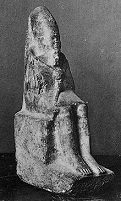
In 2392 B.C.E. Nyuserra dies, and Khentkaus III's son Menkauhor (Ikauhor) Kaiu (Mencheres) (d. -2388) becomes king #7 of the Egyptian Fifth Dynasty, sending an expedition to Sinai and building the Akhet-Ra ("Horizon of Ra") Temple in Abusir (the last Sun temple to be built) before being buried in the Headless Pyramid in Saqqara.

In 2,388 B.C.E. Menkauhor Kaiu dies, and Djedkare (Djedkara) Isesi (Tancheres) (d. -2356) becomes king #8 of the Egyptian Fifth Dynasty.

In 2,356 B.C.E. Kjedkara Isesi dies, and Wenis (Unis) (Unas) (Usas) (Oenas) (Onnos) (d. -2323) becomes king #9 (last) of the Egyptian Fifth Dynasty; his wives are Queen Nebet and Queen Khenut - my wenis needs some nebet and khenut?
About 2,350 B.C. the largest known obelisk in Egypt's Old Kingdom.
In 2,346 B.C.E. Noah (b. -2948) is 602 years old; Shem (b. -2446) is 100 years old; Arpachshad (d. -1909), son of Shem is born, and lives 438 years (Gen. 10:22-24; 11:10-13; 1 Chron. 1:17-27); meanwhile Noah and his three sons and their wives get to work reproducing like rabbits, founding 70 main families, which spread out from Mount Ararat between the Black and Caspian Seas; "From these the nations were spread about in the Earth" (Gen. 10:32); Noah's son Japheth (Heb. "he expands") founds the 14 Indo-European families (Aryan speech): Ham (Heb. "heat") founds the 30 Afro-Asiatic families (Hamitic speech) through his four sons Cush (Ethiopians), Canaan (Canaanites), Mizraim (Egyptians), and Uncle Nasty, er, Phut (Put) (Libyans); Egypt is called the "land of Ham", and their deity Ammon is really Ham-on (Rye?); Shem (Heb. "fame") founds the 26 Asiatic families (Semitic speech); Japheth Branch: Gomer (Cimmerians N of Black Sea), Ashkenaz (SE of Black Sea), Riphath (Paphlagonians), Togarmah (Armenians), Magog, Madai (Medes S of Caspian Sea), Javan (Ionians), Elishah (near Greece), Tarshish (SW Europe and Spain), Kittim (Cyprus), Dodanim (Rodanim) (Rhodes and adjacent islands), Tubal (Tibareni in Asia Minor), Meshech (Phyrians in Asia Minor), Tiras (Tyrrhenians in the Aegean); Ham Branch: Cush (Ethiopians in E Africa and Arabia), Seba (E Africa), Havilah (SW Arabia), Sabtah (S Arabia), Raamah (SW Arabia), Sheba (SW Arabia), Dedan (Arabia), Sabteca (S Arabia/Ethiopia), Mizraim (Egyptians), Ludim (N Africa), Anamim (Egypt), Lehabim (Libyans), Naphtuhim (N Egypt), Pathrusim (Upper Egypt), Casluhim, Philistines (Palestine) (Heb. "Plishtim" = invaders), Caphtorim (Cretans), Put (N Africa), Canaan (W of Jordan River), Sidon (Canaan's son) (Sidonians or Phoenicians), Heth (Canaan's son) (Hittites), Jebusite (Jerusalem), Amorite (Palestine), Girgashite (W of Jordan River), Hivite (Central Palestine), Arkite (W of Lebanon Mts.), Sinite, Arvadite (Syrian coast islands), Zemarite (N of Phoenician Coast), Hamathite (N of Palestine); Shem Branch: Elam (SE of Mesopotamia), Asshur (Assyrians), Arpachshad, Shelah, Eber (Arabia, Mesopotamia), Peleg, Joktan (Arabians), Almodad, Sheleph, Hazarmaveth, Jerah, Hadoram, Uzal, Diklah, Obal, Abimael, Sheba, Ophir, Havilah, Jobab, Lud (Lydians of Asia Minor), Aram (Aramaeans and Syrians), Uz, Hul (near Armenia), Gether, Mash (Syro-Arabian Desert or N Mesopotamia).
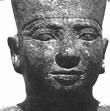
In 2,345 B.C.E. Teti (Othoes) (d. -2333) becomes king #1 of the Egyptian Sixth Dynasty (ends -2181); his mother Queen Sesheshet helps reconcile the two warring factions of the family and get him raised to the throne; in Nov. 2008 her pyramid is discovered in Saqqara (brand new sneakers and clothing, all dressed up for first grade?); in 2000 C.E. the mummy of a physician from the Egyptian Sixth Dynasty (24th cent. B.C.E.) is discovered in Saqqara (12 mi. S of Cairo); there are 82 types of specialists in Egypt, plus one who removes the evil eye; lion's fat is used as a remedy for baldness (and since it's so expensive, who can afford it?). About this time the Kingdom of Yam flourishes in Upper Nubia?
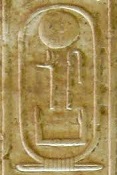
In 2,333 B.C.E. Teti is murdered by his usurper son Userkare (Woserkare) ("Powerful is the soul of Ra") (d. -2332) becomes king #2 of the Egyptian Sixth Dynasty, ruling only 1 (5?) year.

In 2,332 B.C.E. Userkare is killed by Teti's other son Pepi (Pepy) I (Meryre) ("Beloved of Ra") (Neferdjahor) (d. -2255), who becomes king #3 of the Egyptian Sixth Dynasty, going on to aggressively expand into Nubia and expand trade to Lebanon and the Somalian coast; his wives are sisters Ankhesenpepi (Ankhenesmeryre) I and II; too bad, the regional nobility begins to gain power, causing the Old Kingdom to decline.
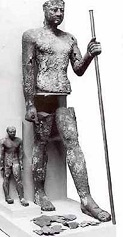


In 2,255 B.C.E. Pepi I dies; his pyramid mortuary complex Mennefer Pepy (Men-nefer) ("Enduring and beautiful") in Lower Egypt is so impressive it gives its name to the area, which the Greeks later call Memphis; he is succeeded by his eldest surviving son Merenre Nemtyemsaf I (d. -2246) as king #4 of the Egyptian Sixth Dynasty.

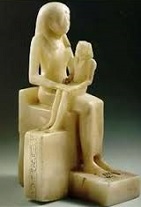
In 2,246 B.C.E. Merenre I dies, and his 4-y.-o. son (by Ankhesenpepi II) Pepi (Pepy) II Neferkare ("Beautiful is the Ka of Ra") (d. -2184) becomes king #5 of the Egyptian Sixth Dynasty, ruling over a crumbling kingdom, and becoming known for being kind to dwarves; Merenre I is really his elder brother, and he rules 96 years?

In 2,184 B.C.E. Pepi II dies an old man, and his old son Merenre Nemtyemsaf II becomes king #6 (last) of the Egyptian Sixth Dynasty, ruling 13 mo.; the Old Kingdom of Egypt (founded -2650) collapses, and an intermediate period begins.

In 2,183 B.C.E. the First Intermediate Period (Egyptian Dynasties 7-11) (ends -2050), a troubled time for Egypt begins, with scrambling for power and overlapping reigns of rival kings; Netjerkare (Netiqerty) Siptah (Nitocris) becomes king #1 of the combined Egyptian Seventh and Eighth Dynasties (ends -2160), in which 70+ fools-for-ya-baby claim the Egyptian throne - look at me, no hair, no eyelashes, no boobs?
In 2,160 B.C.E. Achthoes of Heracleopolis (Herakleopolis) seizes control of Middle Egypt; the Eighth Dynasty ends, and the Egyptian Ninth Dynasty begins (ends -2025), based in Herakleopolis Magna, with up to 18 kings; meanwhile about this year the Egyptian Tenth (10th) Dynasty begins, based in Herakleopolis (ends -2025), with several kings incl. Wahkare Khety and Merikare (Merykare) (Merykara).
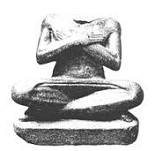
About 2,140 B.C.E. Intef the Elder (the Great), son of Iku becomes king #1 of the Egyptian Eleventh (11th) Dynasty (ends -1991), which eventually refunifies Egypt; its capital is in the city of Thebes on the bend of the Nile in Upper Egypt; it consists of the cities of Karnak in the N half (right or E bank), and Luxor in the S half (right or E bank); the last pyramid tombs are built in this period; the Valley of the Kings is later situated on the left or W bank.
In 2,134 B.C.E. Mentuhotep (Tepya) I (the Great) (d. -2120) becomes king #2 of the Egyptian 11th Dynasty in Thebes.
In 2,120 B.C.E. Mentuhotep I dies, and his son (by Neferu I) Sehertawy ("Pacifier of the two lands") Intef I (d. -2118) becomes king #3 of the Egyptian 11th Dynasty, becoming the first member of the dynasty to claim a Horus name, going to war with Coptite nomarch Tjauti and expanding the kingdom's border 150 mi. northward to Abydos.

In 2,118 B.C.E. Intef I dies, and his brother Wahankh Intef (Inyotef) (Antef) II (d. -2069) becomes king #4 of the Egyptian 11th Dynasty, reigning for almost 50 years.
About 2,100 B.C.E. the Kingdom of Kush of dark-skinned negroids is established in S Egypt, centered around Kerma near the Third Cataract (of seven) on the Nile, flourishing during Egypt's Second Intermediate Period (-1750 to -1570), giving the Egyptians up north somebody to invade and kick around? (ends -1524); a brick palace and large burial mounds (tumuli) are constructed in Kerma.

In 2,069 B.C.E. Intef II dies, and his son Intef (Inyotef) III (d. -2061) becomes king #5 of the Egyptian 11th Dynasty, extending his kingdom's border N against the Egyptian 10th Dynasty, and doing some building in Elephantine; his wife is Iah (Yah) (Jah) (Aah) ("Moon"), who becomes the mother of Mentuhotep II and Queen Neferu.

In 2,061 B.C.E. Intef III dies, and his son (by Iah) Montuhotep (Mentuhope) II (Nebheptre) (d. -2010) becomes king #6 of the 11th Egyptian Dynasty, becoming the first to build his tomb in Deir al-Bahri (al-Bahari) ("the Northern Monastery") in the Theban necropolis on the W bank of the Nile River opposite Luxor.

In 2,010 B.C.E. Mentuhotep II dies after reigning 51 years and reuiniting Egypt in his 39th year on the throne, founding the Middle (Reunified) Kingdom of Egypt (ends -1650), known for boasting about campaigning against the Nubian region of Kush, becoming the earliest Egyptian reference to them; his son Nebhepetre Mentuhotep III (d. -1998) becomes king #7 of the Egyptian 11th Dynasty.
About 2,000 B.C.E the city of Hazor (Hatzor) (Asour) in the Upper Galilee on the trade route between Egypt and Babylon has a pop. of 20K, making it the largest city in the region and head of the Canaanite settlements (Joshua 11:10); it is ruled by Egypt as the holy city for Hathor until Joshua destroys it ca. 1200 B.C.E. (Joshua 11:13, 21); in 2019 seven large basalt staircases are excavated at Tel Hazor.
About 2,000 B.C.E. the first known mention of Jerusalem in written records is by the Egyptians in the Egyptian Execration Texts (Proscription Lists), where it is called Urusalimum or Rusalimum.

In 1,998 B.C.E. Mentuhotep III dies, and Queen Imi's son Nebatwyre Mentuhotep IV becomes king #8 (last) of the Egyptian 11th Dynasty.

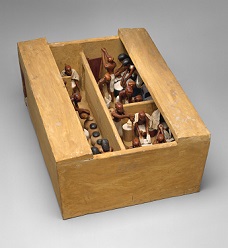

In 1,991 B.C.E. Mentuhope IV dies, and Amenemhet (Amenemhat) (Ammenemes) I (Sehetepibre) (d. -1962) becomes king #1 of the Egyptian Twelfth (12th) Dynasty (ends -1802), moving the capital from Thebes to Ijtawy in the Faiyum region; a golden age begins, producing the Ipuwer Papyrus, becoming the oldest known treatise on political ethics, claiming that a good king controls unjust officials, claimed by some to bolster the Biblical story of Exodus; Amenemhet I is of Nubian origin, from the Aswan region.
In 1,971 B.C.E. Senusret I becomes co-pharaoh with his father Amenemhat I (until -1962).
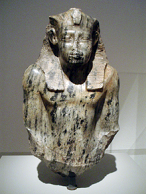
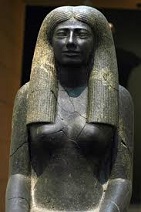
In 1,962 B.C.E. Amenemhat I is assassinated, and his son (by Nefertitanen) Senusret (Seostris) (Senwosret) I Kheperkare ("the Ka of Ra is created") (d. -1926) becomes king #4 of the Egyptian 12th Dynasty after rushing back from a military campaign in Libya, later sending two expeditions into Nubia in -1953 and -1943 which fix Egypt's S border at the 2nd Cataract, where he stations a garrison and erects a victory stele; high priest Djefaihapi (Djefaihap) (Hapdjefai) (Hapidjefa) (Hepzef) of Asyut (Lycopolis) in Upper Egypt leaves a statue of his wife Lady Sennuwy, which is discovered in 1912 C.E. by a Museum of Fine Arts-Harvard U.-sponsored expedition.
About 1,950 the Akhmim Tablets are inscribed with a list of servants' names and a series of grain computations.



In 1,926 B.C.E. Senusret I dies, and his son co-pharaoh (since -1929) Amenemhet II (d. -1895) becomes king #3 of the Egyptian 12th Dynasty; during his reign the tomb of his PM Meketre contains a model bakery-brewery discovered on Mar. 17, 1920 by Am. Egyptologist Herbert Eustis Winlock (1884-1950).

In 1,895 B.C.E. Amenemhet II dies, and his coregent (since -1897) son Senusret (Seostris) II (d. -1878) becomes king #4 of the Egyptian 12th Dynasty, going on to built an extensive irrigation system in the Faiyum region from Bahr Yussef to Lake Moeris, with a dike at El-Lahun, to which he moves the royal necropolis from Dahshur, making it his capital; the first known Egyptian workers quarters is built in the nearby town of Senusrethotep (Kahun).

In 1,878 B.C.E. Senusret II dies, and his son (by Khenemetneferhedjet I) Senusret (Sesostris) III (d. -1839) becomes king #5 of the Egyptian 12th Dynasty, going on to reduce the power of regional rulers, and pacify the S frontier with Nubia, building massive 2nd Cataract forts at Buhen, Semna, and Uronarti, creating an era of peace and prosperity, with a revival in trade, urban development, and crafts, becoming one of the few pharaohs deified and honored with a cult during his lifetime; he digs an E-W canal through the Wadi Tumilat to join the First Cataract of the Nile River with the Red Sea, which reaches N to the Bitter Lakes at this time, allowing direct naval trade with Punt; although of Nubian origin, he bans Nubians from crossing the S end of the 2nd Nile Cataract into Egypt; Egypt goes on to dominate Nubia to about -1000, building Egyptian-style temples and making the aristocracy adopt Egyptian religions and hieroglyphics while taking gold, ebony, and ivory; meanwhile Nubians intermarry with Egyptians, so within a millennium they are almost indistinguishable.
About 1,850 B.C.E. the Egyptian 12th Dynasty Moscow (Golenishchev) Mathematical Papyrus contains 25 math problems.

In 1,839 B.C.E. Senusret III dies, and his co-regent (since -1860) son Amenemhet (Amenemhat) III Nimaatre ("Belonging to the justice of Ra") (d. -1814) becomes king #6 of the Egyptian 12th Dynasty.
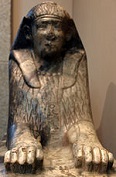
In 1,814 B.C.E. Amenemhet III dies, and his co-regent (since -1815) son Amenemhet (Amenemhat) (Ammenemes) IV (d. -1806) becomes king #7 of the Egyptian 12th Dynasty, going on to send expeditions to Sinai for turquoise and Upper Egypt for amethyst, building the Temple of Renenutet in Medinet Madi, and a great labyrinth "near the place called the City of Crocodiles" near Lake Moeris, described by Herodotus as surpassing the pyramids; too bad, it is lost (until ?).
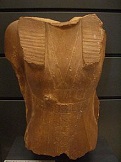
In 1,806 B.C.E. Amenemhet IV dies, and his sister Sobeknefru (Neferusobek) (Sobekkare) ("The beauty of Sobek") (Skemiophris) (d. -1802) becomes king #8 (last) of the Egyptian 12th Dynasty.
In 1,805 B.C.E. the Egyptian Fourteenth (14th) Dynasty (ends -1650) is founded, with capital in Avaris in the NE Nile Delta; the 30+ pharaohs are of Canaanite or W Semitic descent; famine, which began in the late 13th Dynasty plagues this dynasty and the 16th Dynasty.

In 1,803 B.C.E. Sekhemre Khutawy Sobekhotep I (d. -1800). becomes king #1 of the 30-king Egyptian Thirteenth (13th) Dynasty (ends 1718?), based in Memphis, which leaves few monuments, making it hard to determine the chronology; Wegaf (Ugaf) Khutawyre (d. -1757) is the real king #1, not #19?
About 1,800 B.C.E. Semitic workers in the Sinai invent Alphabetic writing by modifying Egyptian hieratic glyphs.
In 1,768 B.C.E. after being pushed out by the Hittites, the Hyksos (Egyptian "rulers of the foreign countries") from W Asia, AKA the shepherd kings, a Syrian group which incl. Semites from Palestine invade the NE Nile Delta and set themselves up in a city called Avaris, where they introduce the horse and chariot; the Middle Kingdom of Egypt ends along with the 12th Egyptian Dynasty, and the Second Intermediate Period begins, incl. the Egyptian 13th-17th Dynasties (ends -1570).

In 1,760 B.C.E. Ameny Intef IV dies, and Hor (Awibre) (Aubrire) (d. -1750) becomes king #3 of the Egyptian 13th Dynasty.
In 1,750 B.C.E. Hor dies, and Sobekhotep II becomes king #4 of the Egyptian 13th Dynasty.
In 1,747 B.C.E. Khendjer ("boar") becomes king #5 of the Egyptian 13th Dynasty.
In 1,745 B.C.E. Sobekhotep III becomes king #6 of the Egyptian 13th Dynasty.

In 1,741 B.C.E. Neferhotep I (d. -1730) becomes king #7 of the Egyptian 13th Dynasty.
In 1,730 B.C.E. Neferhotep I dies, and his Thebes-born brother Sobekhotep IV Khaneferre (d. -1720) becomes king #8 of the Egyptian 13th Dynasty, leading a military campaign into Nubia.
In 1,720 B.C.E. Sobekhotep IV dies, and Ay becomes king #9 king of the Egyptian 13th Dynasty.
In 1,705 B.C.E. Nehesy (Nehesi) ("the Nubian") Aasehre becomes king #6 (#2?) of the Egyptian 14th Dynasty, ruling less than 1 year, becoming the best-attested king of the dynasty, leaving his name on two monuments in Avaris.

In 1,650 B.C.E. the 6-king Egyptian Fifteenth (15th) Dynasty (ends -1550), based in Avaris is founded by the Hyksos after they infiltrate from the NE; the Second Intermediate Period begins (until -1550), during which Egypt is in chaos, continuing through the 17th Dynasty; the 30+-king Egyptian Sixteenth (16th) Dynasty (ends -1580), based in Thebes is founded, facing encroachment from the 16th Dynasty, which evenutally conquers Thebes itself; one possible 16th Dynasty pharaoh is Senusret IV Seneferibre, whose colossal (2m) pink granite statue in Karnak is discovered in 1901.
About 1,650 B.C.E. the Egyptian Mathematical Leather Roll is written, a practice test for students on fractions; also the Rhind Mathematical Papyrus, which contains mathematical problems.

In 1,580 B.C.E. the 9-king Seventeenth (17th) Egyptian Dynasty begins (ends -1550), based in Thebes; king #1 might be Sekhemrewahkhau Rahotep, who leaves a stele in Coptos celebration his restoration of the Temple of Min.
In 1,580 B.C.E. Egyptian (Theban) princess Ahmose Meryet Amon becomes the earliest known human diagnosed with coronary artery disease.
In 1,560 B.C.E. Senakhtenre Ahmose dies, and his son (by Tetisheri) Seqenenre Tao (Taa) (Djehuty-aa) (the Brave) (d. -1556) becomes king #8 of the Egyptian 17th Dynasty in Thebes, initiating military campaigns against the Hyksos.

In 1,556 B.C.E. Seqenenre Tao dies, and his son (by Ahhotep I) Kamose (d. -1550) becomes king #9 (last) of the Egyptian 17th Dynasty, continuing his father's war on the pesky Hyksos.

In 1,549 B.C.E. Kamose dies, and his co-regent brother (since -1546) Ahmose (Amosis) (Amasis) (Aahmes) (Amenes) ("Born of Yah") I (Nebpehtyre) ("The lord of strength is Ra") (d. -1524) (brother of Kamose) expels the Hyksos from the Nile Delta, restores Theban rule over all of Egypt incl. Nubia and Canaan, and founds the fabulous Egyptian Eighteenth (18th) (Thutmosid) Dynasty (ends -1292), known for its imperialism and its superstar pharaohs incl. four named Thutmosis, female pharaoh Hatshepsut, and heretic pharaoh Akhenaten; end of the Second Intermediate Period (begun -1650), and beginning of the Egyptian New Kingdom (Egyptian Empire), which incl. the Egyptian 18th-20th Dynasties, seeing Egypt reach its peak of wealth and power; Amazing Ahmose I builds the last pyramid by native Egyptian rulers.

In 1,524 B.C.E. Ahmose I dies after his two eldest sons Ahmose-ankh and Ahmose Sapair die first, and his son (by Ahmose-Nefertari) Amenhotep (Amenophis) ("Amun is satisfied") I (Djeserkare) (d. -1503) becomes king #2 of the Egyptian 18th Dynasty, ruling 21 years.

In 1,506 B.C.E. Amenhotep I dies, and his military cmdr. (son of Amenhotep I and commoner Senseneb) Thutmose I (Thutmosis) (Thothmes) (Tuthmosis) ("Thoth-Born") (Akheperkare) (d. -1493) becomes king #3 of the 18th Egyptian Dynasty, going on to conquer Nubia past the Fourth Cataract, ending the autonomous Kingdom of Kush (Cush) (Nubia), located at the confluence of the Blue Nile, White Nile, and Atbara Rivers in modern-day Sudan; he becomes the first pharaoh (after Amenhotep I?) to build his tomb in the Valley of the Kings on the W bank of the Nile River opposite Thebes/Luxor; the practice continues for almost 500 years, ending with the Egyptian 20th Dynasty (ends -1077).
About 1,500 B.C.E. the Egyptian Book of the Dead (Book of Emerging Forth into the Light) goes onto the Memphis Times Bestseller List for those wanting to make it to the Field of Reeds (until -50).

In 1,493 B.C.E. Thutmose I dies, and his non-eldest son (by minor wife Mutnofret) Thutmose (Thutmosis) (Tuthmosis) (Thotmes) ("Born of Thoth") II (d. -1479) becomes king #4 of the Egyptian 18th Dynasty; to secure his throne he marries his royal half-sister Hatshepsut, who wears the pants and is the real power behind the throne, claiming that daddy loved her best and wanted her to be his heir.




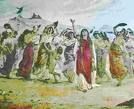

-1491 Traditional date of the First Passover, the Biblical Exodus, and the Red Sea Crossing Caper (Ex. Chs. 12-15), led by Moses; on Nisan 14 the first Passover is held (Ex. 12:1-13), then on Nisan 15 Israel departs from Egypt starting at Memphis, being joined by others from Goshen to the N, eventually growing to 2M-3M, and passing over the El Haj trade route to Succoth, reaching Etham N of the Red Sea; then, to solve some sibling rivalry between the top dogs (er, gods) of the two competing religions, the Jews are ordered by Jehovah to "turn back and encamp before Pihahiroth ("mouth of the gorges") between Migdol and the sea in view of Baal-zephon... by the sea" to the S (Heb. "Yam Suph" = "Red Sea" = Gulf of Aqaba?) (Nueba Beach at the end of Nueba Peninsula at the end of 2K-ft.-high Wadi Watir Canyon?) (Ex. 13:20-14:3), which causes Pharaoh and the Egyptians to think they are lost and harden their hearts and pursue them in 600+ chariots (Ex. 14:7); Jehovah then commands Moses to lift up his rod and stretch his hand out over the sea, parting the waters so the Hebrew nation can walk on the dry seabed (Ex. 14:16); after Jehovah makes the wheels of their chariots come off to slow them down (Ex. 14:25), Moses stretches out his hand over the sea again, causing it to close on the Egyptians and kill them all (Ex. 14:26-28); "But the children of Israel walked upon dry land in the midst of the sea; the waters were a wall unto them on their right hand and on their left. Thus the Lord saved Israel that day out of the hand of the Egyptians, and Israel saw the Egyptians dead upon the sea shore" (Ex. 14:29-30); joyful Moses and the men celebrate by singing the hit Hebrew song "The Horse and Its Rider Hath He Thrown in the Sea" (Ex. 15:1), while Aaron's sister Miriam leads the women with tambourines (Ex. 15:20-21); after providing them with food, quail, and manna and instituting a Sabbath Law (Ex. Chs. 15-16), they finally make it to the Sinai wilderness in the 3rd month after the Exodus (Ex. 19:1-2); Moses goes to the top of Mt. Sinai (Horeb) in Midian for 40 days, and returns with two stone (blue sapphire?) tablets "written on by God's finger" containing the Ten Commandments (Words) (Decalogue), (Ex. 31:18, Deut. 4:13), but breaks them after seeing a group of backsliders singing in front of a golden calf made by his brother Aaron from gold jewelry donated by the backsliders, and he and the tribe of Levi kill all 3K of them (sparing Aaron), asking Jehovah to give the Jews another chance and let Moses make his own copy of the Ten Commandments, which he permits after passing by Moses but only allowing him to see his "back (parts) (side)" (Ex. 33:18-23, 34:1-6; Acts 7:38), causing Moses' face to emit rays so intense that the Jews can't bear to look at him (Ex. 34:29-35; 2 Cor. 3:7-13) (ass-kissing and brown-nosing jokes here?); meanwhile Moses begins compiling the books of Genesis and Exodus, and sprinkles the Book of the Covenant with blood and reads it to the people on the plains of Moab, incl. the Book of Deuteronomy, containing the immortal soundbyte (Shema) (Deut. 6:4): "Here, O Israel, the Lord our God, the Lord is One", to which the people reply: "All that Jehovah has spoken we are willing to do and be obedient" (Ex. 24:3-7, Heb. 9:19), founding the Jewish Religion (Judaism), with Moses' Ten Commandments giving Jews a way to beat the curse of Adam and gain eternal life if one never disobeys them, which it turns out all do, esp. when all 613 Commandments (Mitzvot) are taken into consideration, making it necessary for them to be perfected by Christianity - from now on, people can't break God's law, only break themselves on it? The Red Sea Crossing happened no later than -1400 because the Egyptian Eighteenth Dynasty is the only one that used both 4-spoke and 6-spoke chariot wheels, corresponding to coral formations on the floor of the Gulf of Aqaba at both ends of an undersea ridge that makes the gulf passable by foot if the water were removed?




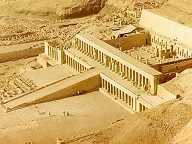
In 1,479 B.C.E. after her 2-y.-o. stepson Thutmose III ascended the throne last year, Thutmose II's chief wife (daughter of Thutmose I and Ahmes) Hatshepsut (Hatchepsut) ("Foremost of noble ladies") (d. -1458) (Hot Sheep Shit?) becomes king #5 of the Egyptian 18th Dynasty, becoming Egypt's first female pharaoh, ruling 21 years 9 mo. while bowing to male supremacists by wearing a man's pants and beard, while trying to get her daughter (only child) Nefrure knocked, er, set up as her heir; in year 9 of her reign she goes on an Expedition to Punt in five 70-ft.-long ships, each carrying 180 sailors and 30 rowers, buying frankincense and myrrh, returning with 31 live myrrh trees, which she transplants; she goes on to commission hundreds of building projects under chief architect Ineni (Anena) (previously used by Amenhotep I, Thutmose I, and Thutmose II), restoring the Temple of Mut in Luxor on the E bank of the Nile River, which had been destroyed by the Hyksos illegal immigrants; her other chief architect Senenmut ("mother's brother") designs her mortuary temple complex at Deir el-Bahri on the W bank of the Nile River near the entrance to the Valley of the Kings, incl. the Djeser-Djeseru ("sublime of the sublimes") Mortuary Temple (holy of holies), next to the mortuary temple of Amentuhotep II, dedicated to the sun god Amun; Senenmut's tomb in Thebes contains an astronomical ceiling containing the earliest known star map in Egypt.

In 1,458 B.C.E. Hatshepsut dies, and Thutmose II's son (by minor wife Iset) Thutmose (Thutmosis) (Thutmoses) (Tuthmosis) (Thutmes) ("Thoth-born") III (d. -1425) (co-regent with his stepmother-aunt Hatshepsut since 1479) AKA the Napoleon of Egypt becomes king #6 of the Egyptian 18th Dynasty, expanding Egypt to its greatest size in 17 campaigns, conquering from Niya in N Syria to the Fourth Cataract of the Nile River in Nubia, and ruling almost 54 years; he builds the city of Napata on the W bank of the Nile River past the Fourth Cataract near modern-day Karima, Sudan (250 mi. N of Khartoum), becoming the seat of the "King's Son of Kush" (Egyptian viceroy), with a pop. of 100K; he erects many obelisks all over Egypt; too bad, he and his successor try to obliterate Hatshepsut's name from statues and monuments.
On Apr. 26, 1,457 B.C.E. Thutmoses III (the Napoleon of Egypt, who never loses a battle) defeats the rebellious Caananites, led by the king of Kadesh at the Battle of Megiddo, the crossroads of the Middle East.
In 1,453 B.C.E. Egypt finishes conquering the Canaanite city-states of the Levant, establishing the Kinakhna Province.

In 1,425 B.C.E. Thutmose III dies, and his son Amenhotep (Amenophis) ("Amun is Satisfied") II (Akheperure) (d. -1397) becomes king #7 of the Egyptian 18th Dynasty, ending hostilities with the Mitanni in Syria; the real Exodus Pharaoh?
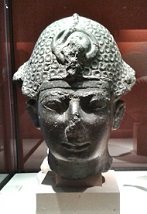
In 1,397 B.C.E. Amenhotep II dies, and his son (by Tiaa) Thutmose (Thutmosis) (Thutmosis) IV Menkheperure ("Established in forms is Ra") (d. -1388) usurps his older brother to become king #8 of the Egyptian 18th Dynasty, going on to restore the Sphinx in Giza and commission the Dream (Sphinx) Stele, describing how he had a dream that if he restored it he would become pharaoh, bolstering his legitimacy claims.


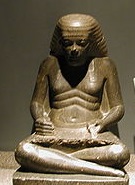
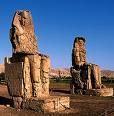
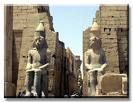

In 1,388 B.C.E. Thutmose IV dies after having a vision from the god Horus to clear the sand covering the Sphinx, and in June his son (by queen Mutemwiya) Amenhotep III (Amana-Hatpa) ("Amun is Satisfied") (the Magnificent) (Nebmaatre) (d. -1351) becomes king #9 of the Egyptian 18th Dynasty; in his 2nd year of rule he marries his wife (identified as the Elder Lady in the tomb of Amenhotep II in 2010) Queen Tiy (Tiye) (Tiyhi) (Ty) (Taia), who rules as virtually his equal (not that the high priest of Amon-Ra doesn't hold the supreme power now?); a statue of the goddess Ishtar is sent to him by the city of Nineveh by orders of the king of Mitanni; after hiring architect Amenhotep, son of Hapu, he builds the Colossi of Memnon and the Temple of Luxor; the Tomb of Nebamun in Thebes, discovered in 1820 features the Two Nude Girls of Thebes.
In 1,363 B.C.E. Eriba-Adad I dies, and his son Ashur-Uballit I (d. -1328) becomes king of Assyria; he revolts against the Mitanni under Shuttarna II, conquers them, reclaims Nineveh, and founds the Assyrian Empire, styling himself "king of the Universe", and writing the Amarna Letters to the king of Egypt - make me a shedu?
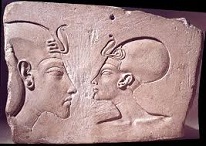

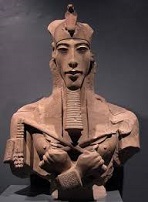

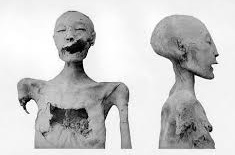

In 1,351 B.C.E. Amenhotep III dies (from complications caused by abscesses in his teeth?), and his son (co-regent since -1353) Amenhotep (Amenophis) ("Amun is satisfied") IV (-1384 to -1334) (later Akhenaten) becomes king #10 of the 18th Egyptian Dynasty at Thebes; his sister-wife is luscious eye liner-wearing ruby-red-lipped "Lady of the Two Lands" Nefertiti (Ankhkheperure Neferneferuaten) (-1370 to -1330) ("Nefer" = beautiful, "Titi" = er, arrived), daughter of the equally luscious Queen Tiy; they have six daughters, incl. the three "senior princesses" Meritaten (Merytaten) (Meryetaten) (-1350 to ?) ("beloved of Aten"), who marries her brother Smenkhkare, Meketaten (-1349 to ?) ("protected by Aten"), and Ankhesenpaaten (Ankhesenamen) (-1348 to -1323), who marries King Tutankhamun, and whose statue is discovered in the 1930s by English archeologist Mary Chubb (1903-2003); Akhenaten, Nefertiti, and Tut have elongated skulls, spawning theories that they are part alien; in 1955 Irish archeologist Sean P. O'Riordan (1905-57) of Trinity College, Dublin discovers a necklace of Egyptian-style fired faience beads in the Mount of Hostages in Tara, Ireland, along with a golden collar similar to Tutankhamun's, proving intercourse with the Celts?
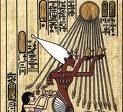


In 1,347 B.C.E. hippo-hipped, sagging-paunched, tiny-chested, pencil-necked (first to have realistic statues of himself made without fake handsome face, broad shoulders, narrow hips and long legs?) Amenhotep IV decides to hold a Sed festival in his 3rd reignal year (instead of the usual 30th reignal year as is customary), and next year dumps Amen (Amon) for the Sun disk Aten (Aton) (pissing-off the rich priests of Amon, who have generations of tribute in their treasury?), changes his name to Akhenaten (Akhenaton) (Akhnaten) (Ikhnaton) (Khuenaten) ("effective/beneficial for Aten") (-1384 to -1334) (-1362 to -1336?) ("it is well with Aten", "servant of Aten") (Beautiful Child of the Sun), becoming the first monotheist in history, establishing the monotheistic Sun-disk Religion of Aten in Egypt (worshiping the power behind the Sun, not the physical Sun?), and ordering the building of a new city 200 mi. N of Thebes at Aketaten ("horizon of Aten"), now known as El-Amarna (Amarna) (on the E bank of the Nile halfway between Cairo and Luxor) (pop. 20K), which is hastily built in two years with shoddy materials and untrained workers using limestone blocks, complete with a new temple that breaks the old habit of worshipping in dark sanctuaries, with plenty of sunlight streaming in, which the pop. never gets used to; meanwhile maybe-it's-Maybelline royal sculptor Thutmose (Thutmosis) (Dhutmose) at Amarna takes plaster casts from living faces, incl. Akhenaten, and breaks the old taboo by showing his real figure, complete with fat hips and effeminite chest, playing with children; Akhenaten becomes the first pharaoh to make his servants bow and scrape, building resentment which comes back at him in only 16 years; the title "pharaoh" (great house) is first used in an address to Akhenaten by a foriegn ruler; was Aten really the 10-tailed Great Comet of 1486 B.C.E.?
In 1,347 B.C.E. King Tut receives the desperate Amarna Letters from Canaan, begging for assistance against the pesky Apiru (Hapiru) (Habiru) ("stateless", "dusty, dirty") Asiatics threatening to take over the land; the origin of the word "Hebrew"?
On Jan. 2, 1,345 B.C.E. in the 5th year of his reign, Amenhotep IV officially changes his name to Akhenaten.
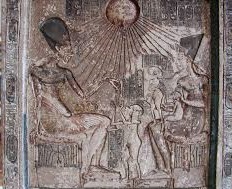

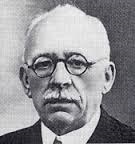

In 1,343 B.C.E. Akhenaten officially moves the Egyptian capital from Thebes to Amarna, although the new city isn't finished for two more years, during which time the famous polychrome painted limestone (or limestone core covered with thin plaster) Bust of Queen Nefertiti is sculpted by Thutmose, and discovered in his workshop in Tell el-Amarna by German archeologists led by Ludwig Borchardt (1863-1938) in 1912, along with a Stela of Akhenaten and His Family; too bad, on Jan. 20, 2013 French Egyptologist Gustave Lefebvre (1879-1957) chooses the stela to go to the Egyptian govt., allowing the bust to go back to Germany, ending up in the Egyptian Museum in Berlin, after which the stela is suspected of being a fake.
On Nov. 21, 1338 B.C.E. Meketaten, daughter of Nefertiti is mentioned for the last time; meanwhile Nefertiti is elevated to co-regent?

In 1,335 B.C.E. Nefertiti and four of her six daughters mysteriously disappear, and Akhenaten's brother Smenkhare becomes co-regent of Egypt with Akhenaten, with his wife (half-sister?) (half-niece?) Meritaten (Merytaten) (Meryetaten) ("Beloved of Aten") (-1350 to ?) as "great royal wife"; is Smenkhare really Nefertiti in disguise, and Meritaten's title mean that she is another wife of Akhenaten, or merely assumed her mother's ceremonial duties?
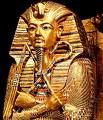
In 1,334 B.C.E. the first known plague hits Egypt; Akhenaten (b. -1384) dies, leaving the most statues of himself to survive to modern times (250), even though his likeness is erased from many monuments by his hate-filled people; his sickly 20-y.-o. brother Smenkhkare (Smenkare) (Smenkhkara) ("Living are the forms of Ra") (Ankhkheperure Smenkhare Djeser Kheperu) (-1353 to -1334) becomes king #11 of the 18th Egyptian Dynasty at Amarna, but dies in Thebes within a year (of plague?).

In 1,333 B.C.E. 8-y.-o. Tutankhaten ("living image of Aten") (Nebkheprure) (King Tut) (-1341 to -1323) (son of Amenhotep III and Tiy), who married his niece Ankhesenpaaten (daughter of Nefertiti and Akhenaten) to gain the succession becomes king #12 of the 18th Egyptian Dynasty at Amarna, staying with the religion of Atenism until Nefertiti dies (but obviously wanting to dump it since the plague sends him a divine message that Aten sucks?); being the son of a brother-sister, he suffers from Kohler's Disease, which gives him feminine hips, pronounced overbite, and a progressive loss of bones in his foot, causing lifetime excruciating pain; he comes to power only after two of his sisters jointly hold the throne?
In 1,330 B.C.E. Nefertiti (b. -1370) dies, and Tutankhaten renounces red hot Aten, dropping him like a hot potato and changing his name to Tutankhamen ("Living image of Amun"), and his wife's to Ankhesenamen, then returning to good ole Thebes.

In 1,323 B.C.E. King Tut (b. -1341) dies at age 19 of a leg fracture and malaria, and is buried in the Valley of the Kings in Thebes; his tomb is found in 1922 C.E. by Howard Carter (1874-1239) of England; in 2005 Maria Rosa Guasch-Jane et al. of the U. of Barcelona find that he drinks red wine from traces found in his tomb; in 2013 it is discovered that after burial his mummified body spontaneously combusted; in 2010 DNA tests indicate that Tut is of W European (as in Celtic?) origin; 70-y.-o. Lord Ay (Kheperkheperure) ("Everlasting are the manifestations of Ra") (d. -1319) (former servant of Akhenaten and Nefertiti) becomes king #13 of the 18th Egyptian Dynasty at Thebes.

In 1,319 B.C.E. King Ay dies, and despite having named his son Nakhtmin as his successor, army CIC Gen. Horemheb (Horemhab) (Haremhab) ("Horus is in jubilation") (Djeserkheperure) (d. -1292) becomes king #14 (last) of the 18th Egyptian Dynasty at Thebes; four years after Tutankhamen dies, an outbreak of hatred against Atenism in Egypt causes Horemheb to order all traces of Atenism wiped out, Amarna destroyed, the great temple pulled down and covered with cement, the name and likeness of Akhenaten removed from all monuments, and Akhenaten's mummified body burned.


In 1,292 B.C.E. King Horemheb dies leaving no heir, and the aged high priest of Amon, Rameses (Ramses) (Ramesses) I (Menpehtyre) (-1280 to -1290), born a commoner from a military family (son of military cmdr. Seti) becomes king #1 of the Egyptian Nineteenth (19th) Dynasty (ends -1187), becoming the top Egyptian dynasty (it's all downhill after that), which is big on the god Seth (storm god, who guards Ra as he journeys across the sky, and killed and cut up his brother Osiris); he rules less than two years, waging war in Nubia and facing attacks by the Libyan Berber Meshwesh (Ma) from the desert, while beginning the pillared Hall of Karnak; all royal mummies of the 19th Dynasty have their arms crossed high on their chest, which is not done again until Roman times (1 C.E.); in 1860 Dr. James Douglas of Montreal, Canada, buys his mummy from tomb robber Mustafa Agha Ayat and takes it to the Niagara Falls Museum in Ont., Canada (founded 1827), where it is discovered in 1966 by German amateur Meinhard Hoffmann, who at first believes it is Nefertiti until it is discovered to be male; after purchase by Emory U., Egyptologist Zahi Hawass (1947-) certifies it in Apr. 2003, and it is put on display in the Cairo Museum.


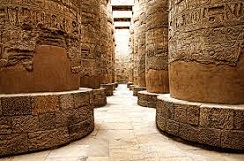
In 1,290 B.C.E. Rameses I dies, and his son (by Sitre) Seti I (Sethos) ("Of Seth") (Menmaatre) ("Established is the justice of Ra") Merenptah ("Beloved of Ptah") (d. -1279) becomes king #2 of the Egyptian 19th Dynasty, conducting two campaigns in Syria to stop the advance of the Hittites and reestablish the empire of Thutmose III in Palestine and Syria; he builds the Great Temple of Osiris in Abydos to restore worship of Egypt's traditional gods, with a depiction of Isis' constellation Orion; he also decorates the walls of the Great Hypostyle Hall in Karnak, which is completed by his son Rameses II.

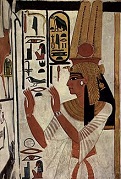
In 1,279 B.C.E. Seti I dies, and his 5'8" (tall) E Medterranean-looking (long thin face, beaked nose, strong jaw) reddish-blond teenie son Rameses (Ramesses) (Ramses) II (the Great) (-1303 to -1213) becomes king #3 of the Egyptian 19th Dynasty, the #1 pharaoh in Egyptian history; he marries glam babe Nefertari ("Beautiful companion") Meritmut ("Beloved of Mut"), and with her and his other wives Isetnofret (Isitnofret) ("Beautiful Isis") et al. he fathers 100+ children; he puts his face on the red granite Sphinx in the Temple of Ptah in Memphis, which survives to modern times sans face; he builds up his N capital of Pi-Ramesses (Per-Rameses) ("House of Rameses, Great in Victory") in Qantir near Avaris, the former Hyksos capital; he is addicted to tobacco?
In 1,278 B.C.E. Rameses II decisively defeats the Sherden (Shardana) (Sherdanu) sea pirates (known for their horned helmets) along the Mediterranean coast.
In 1,276 B.C.E. Rameses II recaptures the district of Phoenicia (Canaan) from the Hittites as far E as Berytus (Beirut), and leaves a memorial stele on the bank of the Nahr al-Kalb (Dog) River N of Beirut.
In 1,274 B.C. in the 5th year of his reign Rameses (Ramses) II and his 16K infantry and 2K heavy chariots defeats the Hittites and their 15K-40K infantry and 2.5K-3.7K heavy chariots under king (-1295 to -1272) Muwatallish (Mutallu) (d. -1272) (son of Mursili II) at the Battle of Kadesh (Quadesh) on the banks of the Orontes River in N Syria, becoming the earliest battle in human history for which military tactics are known; the Egyptian army uses highly mobile archers on their chariots, which win the day (actually a draw?); too bad, Rameses II is cut off from the main body of his troops and narrowly escapes, causing Egyptian scribe Pentaur to write The Poem of Pentaur in his praise; Rameses never captures the city of Kadesh, and the war drags on for years, ending with a peace treaty; a faience tile from the mortuary temple of Rameses III (not II) shows a moustachioed Hittite captive wearing a cool short kilt under a bright (Libyan?) mantle.
About 1,250 B.C.E. the Bronze Age Collapse begins (ends -1100), caused by severe drought and cold in the Fertile Crescent, driving peoples S, incl. the Sea People (from the Aegean?), who bring the opium poppy, cumin, and the sycamore tree.
-1233 - Done Momming? I'll Show Ya? The Egyptian Eggplant Trick Year?

In 1,233 B.C.E. at the climax of the year's largest religious festival in Thebes, 70-y.-o. Pharaoh (since -1279) Rameses (Ramesses) (Ramses) II (the Great) (-1303 to -1213) stands on the pyramid and lifts his short white robe to reveal to 300K adoring Egyptians an erect thebesing penis, causing them to cheer after seeing that their pharaoh's staff is mighty and that Egypt will prosper; he dies after fathering 100+ (1K+?) children, causing everybody in Egypt to end up looking like him?; according to Norman Mailer, nothing like this happens again until the days of U.S. Pres. Bill Clinton - a lost invention of Egyptian Viagra, or the eggplant trick of John Barth's "Sot Weed Factor"?


In 1,213 B.C.E. nicotine-loving Rameses II the Great at age 96, and in late July his 14th (13th?) old fart son (by 2nd wife Isetnofret) Merneptah (Merenptah) (d. -1203) becomes king #4 of the Egyptian 19th Dynasty (until May 2, 1203), marrying his sister Isetnofret (Isisnofret) (Isitnofret) II as well as Takhat, going on to battle the Sea People, Libyans, and Israelites, moving the capital ffrom Pi-Ramesses to Memphis, where he constructs his royal palace next to the Temple of Ptah; ordering the Merneptah Stele (Stela) erected (in -1208?), the last lines of which read: "Canaan is plundered with every hardship. Ashkelon is taken, Gezer captured, Yanoam reduced to nothing. The people of Israel (Isrir) are laid waste, their seed is no more"; the earliest known non-Biblical reference to Israel, and the only known mention of Israel in Egyptian monuments; Rameses II's mummy is interred at Biban al-Muluk, then put in a secret shaft at Deir-el-Bahri ("the northern monastery"), where it is found in 1881 C.E.
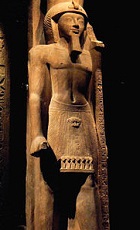
In 1,203 B.C.E. Merneptah dies, and his son (by Isetnofret II) Seti (Sethos) ("Of Set") II (Userkheperure Setepenre) ("Powerful are the manifestations of Ra, the chosen one of Ra") (d. -1197) becomes king #5 of the Egyptian 19th Dynasty, going on to appoint Syrian official Bay (Ramesse Khamenteru) (-1192) as high chancellor, who becomes the first non-royal to build his tomb in the Valley of the Kings, along with Pharaoh Merenptah Siptah and Pharaoh Twosret.

In 1,201 B.C.E. Amenmesse (Amenmesses) (Amenmose) (Menmire Setepenre) (d. -1198), son of Merneptah and Takhat (Rameses II?) usurps the throne from Seti II, making a mess of his monuments and erasing his name until Seti II defeats him in -1198 and returns triumphantly to Thebes, cleaning up his gawd-awful mess.
About 1,200 B.C.E. sheep-goat's-milk cheese is put in the tomb of high-ranking Egyptian official Ptahmes, becoming the oldest known solid cheese.
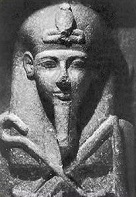
In 1,197 B.C.E. Seti II dies, and in Dec. with the help of kingmaker Chancellor Bay, his (Amenmesse's?) 10-y.-o. son (by Shoteraja/Sutailja) Merenptah Siptah (Akhenre Setepenre) (d. -1191) becomes king #7 of the Egyptian 19th Dynasty, executing Chancellor Bay in the 5th year of his reign for getting too uppity.
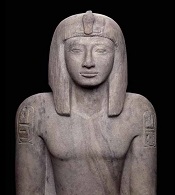
In 1,191 B.C.E. Merenptah Siptah dies, and Seti II's 2nd wife (sister of Amenmesse?) Twosret (Tausret) (Tawosret) (Sitre Meryamun) ("Daughter of Ra, beloved of Amun") (d. -1189) becomes king #8 (last) of the Egyptian 19th Dynasty, ruling 1.5-3 years after absorbing Siptah's regnal years into hers to stretch it to seven years, building the Temple of Millions of Years in Gournah.
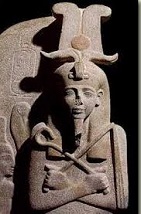
In 1,189 after a civil war, Twosret dies, and usurper Setnakhte (Setnakht) (Sethnakht) (d. -1186) becomes king #1 of the Egyptian Twentieth (20th) Dynasty (ends -1077), refusing to acknowledge the two previous pharaohs, and marrying Tiy-merenese (Teye-Merenaset) (Tiye-Mereniset) (daughter of Merenptah?) in an attempt to make his rule more legitimate; too bad, his reign is marked by the corruption of the govt. by increasingly powerful priests.
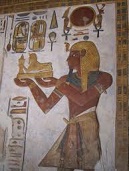
In 1,186 B.C.E. Setakht dies, and his son (by Tiy-Merenese) Usimare Rameses (Ramses) (Ramesses) III (Rhampsinitus) (d. -1155) becomes king #2 of the Egyptian 20th Dynasty, and the last great pharaoh of the New Kingdom, seeing a series of invasions (incl. the Sea People) and economic problems bring the kingdom into decline; the rest of the Rameses line are whimps, often elderly, and with short, er, reigns?; he marries Tyti; references to Punt drop out after his reign, indicating the introduction of camel caravans in Arabia that end their maritime trade; Rameses III's mummy is found at Deir-el-Bahri in 1881 C.E.
In 1,179 B.C.E. in the 8th year of his reign, Rameses III wins the naval Battle of the Delta against the piratical Sea People AKA the Peleset AKA the Philistines, who left the S shore of Asia Minor and settled in SW Canaan on the S coastal plain and were making forays into the Nile Delta.

In 1,175 B.C.E. Rameses III builds his temple palace at Medinet Habu on the W Bank of the Nile in Luxor; the Mortuary Temple of Ramses III in Medinet Habu celebrates his Vs over the Sea People.
In 1,174 B.C.E. Rameses III repels a Libyan invasion.
In 1,173 B.C.E. Rameses III defeats the tall blonde-blue (aquiline noses, pointed beards) Amorites of Palestine, bringing back their king along with rich booty which he uses to endow temples to Amon, esp. at Thebes.

In 1,155 B.C.E. Rameses III dies, and after the first four sons have already died, his 5th son (by Tyti) Heqamaatre Rameses (Ramses) (Ramesses) IV (Amonhirkhopshef) (d. -1149) becomes king #3 of the Egyptian 20th Dynasty, which is increasingly dominated by the priesthood, making pharaohs into puppets; his wife is Duatentopet (Tentopet).
In 1,150 B.C.E. a robber confesses under torture to violating the tomb of Ramses II then going "across the path" to rob the tomb of his sons.
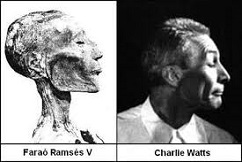
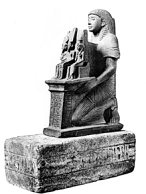
In 1,149 B.C.E. Rameses IV dies, and his son (by Duatentopet) Usermaatre Sekheperenre Rameses (Ramses) (Ramesses) V (d. -1145) becomes king #4 of the Egyptian 20th Dynasty, suffering the power of the priests of Amun, led by high priest Ramessesnakht, who control the temple land and state finances, incl. a financial scandal by the priests of Elephantine; Libyan raiding parties interrupt workmen in Deir el-Medina working on his tomb.

In 1,145 B.C.E. Rameses V dies of smallpox, and his uncle (son of Sameses III and Iset Ta-Hemdjert) Rameses (Ramses) (Ramesses) VI Nebmaatre-meryahum ("Lord of justice is Ra, beloved of Amun") (Amenhirkhepshef II) (d. -1137) usurps the throne, becoming king #5 of the Egyptian 20th Dynasty; his tomb is built over the entrance to Tutankhamun's, protecting it, which is lucky since it is robbed soon after the burial, and the graverrobbers hack off his hands and feet to get at the jewelry.

In 1,136 B.C.E. Rameses VI dies, and his son Usermaatre Setepenre Meryamun Rameses (Ramses) (Ramesses) VII (Itamun) (d. -1129) becomes king #6 of the Egyptian 20th Dynasty.


In 1,129 B.C.E. Rameses VII dies, and Rameses III's last surviving son Usermaatre Akhenamun Rameses (Ramses) (Ramesses) VIII (Sethhirkhepeshef Meryamun) ("Set is his strength, beloved of Amun") (d. -1129) becomes the lucky king #7 of the 20th Dynasty, ruling up to 1 year, becoming the only 20th Dynasty pharaoh whose tomb has not been identified in the Valley of the Kings; Rameses VIII dies, and Rameses III's grandson (via Mentuherkhepeshef and Takhat) Rameses (Ramses) (Ramesses) IX (Khaemwaser I) (Neferkare Setepenre) ("Beautiful is the soul of Ra, chosen of Ra") (d. -1111) becomes king #8 of the Egyptian 20th Dynasty, reigning 18 years 4 mo.; Amenhotep becomes high priest of Amun, who continues to serve under Rameses X and Rameses XI; a Theban tomb-robbing scandal rocks his admin. during regnal years 16-17.

In 1,111 B.C.E. Rameses IX dies, and (his son?) Rameses (Ramses) (Ramesses) X (Amonhirkhepeshef Khepermaatre) ("The justice of Ra abides") (d. -1107) becomes king #9 of the Egyptian 20th Dynasty, becoming the last New Kingdom pharaoh to rule over Nubia; meanwhile Libyan Berber Meshwesh (Ma) from the desert maraud in the Valley of the Kings, slowing workmen.


In 1,107 B.C.E. Rameses X dies, and (his son?) Rameses (Ramses) (Ramesses) XI (Khaemwaset II) (Menmaatre Setpenptah) (d. -1077) becomes king #10 (last) of the Egyptian 20th Dynasty, reigning for 29-30 years; his wife is Tentamun ("She of Amun"), who bears him Duathathor-Henuttaway (Henttawy) ("Adorer of Hathor, mistress of the Two Lands"), who marries Pinedjem I, high priest of Amun at Thebes in -1070 to -1032, who becomes the de facto ruler of 21st Dynasty Upper Egypt starting in -1054.
About 1,100 B.C.E. The Instruction of Amenemope is written by Amenemope, a resident of Akhim in Upper Egypt on the E side of the Nile River; really written by pharaoh Amenenope (-1001 to -992)? - sounds mightly like Proverbs?
In 1,090 B.C.E. (18th year of Rameses XI) Amun high priest Amenhotep is ousted by Pinehesy (Panehesy) (Panehasy), viceroy of Kush, causing Rameses XI to begin counting his regnal years over starting with 1 in the Wehem Mesut (Renaissance), a year of rebirth after years of drought are ended by an unusually high inundation of the Nile River.

In 1,077 B.C.E. Rameses XI dies, ending the New Kingdom (begun -1550), and the Third Intermediate Period (ends -664) in Egypt begins, marked by political instability, division, decline, and foreign conquest, while the pharaohs mainly control Lower Egypt (from Tanis) and the high priests of Amun in Thebes de facto rule Middle and Upper Egypt; Lower Egypt gov. (based in Tanis) Hedjkheperre Setepenre ("Bright is the manifestation of Ra, chosen of Amun") Smendes (Smedes) Nesbanebdjed ("He of the Ram, Lord of Mendes") (d. -1052) (son of Hrere, chief of the harem of Amun-Ra) and Smendes' brother-in-law Hrihor (Herihor) (Her Hor) (high priest of Amon in Karnak since -1080) dethrone Rameses (Ramses) (Ramesses) XII (son of Rameses VII) and divide Egypt between them, with Lower Egypt going to Smedes, with admin. center at Tanis (Djanet) (Zoan in the Bible) (later Thebes of Lower Egypt) (modern-day San El Hagar) on the Tanaitic branch of the Nile in the NE Nile Delta (built after the branch that runs by Pi-Ramesses silts up), and Upper Egypt to Hrihor, who rules out of Amon-Ra's wealthy city of Thebes, founding the Egyptian Twenty-First (XXI) (21st) (Tanite) Dynasty (ends -943).
In 1,051 B.C.E. Neferkare (Nephercheres) Amenemnisu (Neferkare-Heqawaset) (d. -1047) becomes king #2 of the Egyptian 21st Dynasty.


In 1,047 B.C.E. Amenemnisu dies, and Pinedjem I's son (by Henuttaway, daughter of Ramesses XI and Tentamun) Psusennes (Pasebkhanut) (Pasibkhnu) (Hor-Pasebakhaenniut) ("The star appearing in the city") (Akheperre Setepenamun) ("Great are the manifestations of Ra, chosen of Amun") I (d. -1001) becomes king #3 of the Egyptian 21st Dynasty at Tanis, and takes the title of High Priest of Amun (Amon); his wife-sister is Mutnedjemet (Mutnodjme); he builds up the capital city of Tanis with the Temple of Amun-Re (Amon-Ra), which is added to until the time of Shoshenq III (-798).
In 1,045 B.C.E. Menkheperre (son of Pinedjem I and Duathathor-Henuttaway, daughter of Rameses XI and Tentamon) becomes high priest of Amun at Thebes (until -992), going on to pardon several leaders of a rebellion who had been exiled to the Western Oasis during the reign of Smendes.


On May 9, 1,012 B.C.E. a solar eclipse is observed in the Egyptian city of Ugarit during the reign of Amenhotep IV, shifting all of Egyptian chronology forward by 300 years, according to the New Chronology of English Egyptologist David Michael Rohl (1950-).
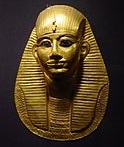
In 1,001 B.C.E. Psusennes I dies, and his son (by Mutnedjmet) Usermaatre Amenemope (Amunemope) (Amenophthis) (d. -992) becomes king #4 of the Egyptian 21st Dynasty, claiming the title of high priest of Amun in Tanis; the Onomasticon of Amenope, an inventory of Egyptian property survives to modern times.
About 1000 B.C.E. the continual grave robbing in the Valley of the Kings causes the royal mummies to be secreted in a common location for guarding; they are safe until the 19th cent., when the Abdul Rassal family discovers them in Deir al-Bahri and begins grave-robbing and selling the loot on the black market?

About 1000 B.C.E. a tomb in Luxor, Egypt for Egypt's chief beer brewer is laid; discovered in 2005.
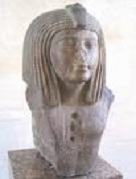
In 992 B.C.E. Amenemope dies, and Osorkon (Osochor) the Elder (Aakheperre Setepenre) (d. -986), son of Shoshenq A of the Berber Libyan Ma (Meshwesh) becomes king #5 of the Egyptian 21st Dynasty, becoming the first pharaoh of Libyan extraction.
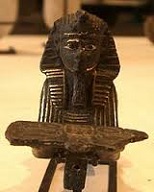
In 986 B.C.E. Osorkon the Elder dies, and Siamun ("Son of Amun") (Netjerkheperre-Setepenamun) ("Like a god is the manifestation of Ra, Chosen of Amun") (d. -967) becomes pharaoh #6 of the Egyptian 21st Dynasty.
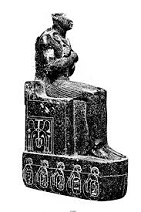
In 967 B.C.E. Siamun dies, and high priest of Amun Psusennes II (Pasebkhanut) (Titkheperure) (Tyketkheperre) (Hor-Pasebakhaenniut II) ("Image of the transformations of Ra") (d. -943) becomes king #7 (last) of the Egyptian 21st Dynasty.
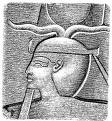
In 943 B.C.E. Psusennes II dies, and Shoshenq (Sheshonq) (Sheshonk) I (d. -922) becomes king #1 of the Libyan (Berber Meshwesh tribe) Twenty-Second (XXII) (22nd) (Libyan Bubastite) Dynasty in Egypt, which lasts more than two cents. (until -715); he rules from the city of Bubastis (Per-Bast) ("House of Bastet") (Tell-Basta) in the Nile Delta, and goes on to wage a successful campaign against the kingdoms of Canaan, Philistia, Syria, Judah, Israel, and the Negev, conquering Megiddo, Byblos et al. (not Jerusalem?); the Shishak of the Bible? (1 Kings 14:25, 2 Chron. 12:1-12)

In 926 B.C.E. Solomon's Temple of Jehovah in Jerusalem is plundered by the Egyptians in the 5th year of Judean king Rehoboam by his protector Pharaoh Shishak (Sheshonq I?), who allegedly carries the Ark of the Covenant to Tanis, as mentioned in the first Steven Spielberg Indiana Jones flick Raiders of the Lost Ark (1981); he takes all the treasures of the Jewish Temple and the king's house, incl. the gold shields of Solomon, which Rehoboam replaces with copper ones (1 Ki. 14:25-28, 2 Chron. 12:1-12).

In 922 B.C.E.Tanis is buried in a month-long sandstorm; Shishak I dies, buried along with the Ark of the Covenant :), and his son (by Karomat A) Osorkon I (d. -887) becomes king #2 of the Egyptian 22nd Dynasty, going on to build many temples.

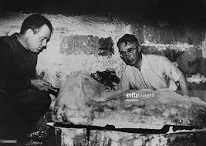
In 887 B.C.E. Osorkon I dies, and his son Shoshenq (Shishenq) (Haqakheperre) II (d. -885), becomes king #3 of the Egyptian 22nd Dynasty, becoming the only king of this dynasty whose tomb isn't plundered because it is hidden inside an antechamber of Psusennes I's tomb in Tanis; in the 1939-40 season French Egyptologist Jean Pierre Marie Montet (1885-1966) discovers the intact tombs of Pharaoh Psusennes I, Pharaoh Amenemope, and Pharaoh Shoshenq II, along with the partially-plundered tomb of Takelot I, and the fully-plundered tomb of Osorkon II in Tanis; on May 20, 1939 he removes Shoshenq II's coffin lid in the presence of King Farouk of Egypt, and discovers a hawk-headed silver coffin, gold funerary mask, and a treasure trove of jewel-encrusted bracelets and pectorals.
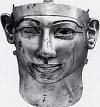
In 885 B.C.E. Osorkon I dies, and his son (by Tashedkhons) Takelot I (Hedjkheperre Setepenre) (d. -872) becomes king #4 of the Egyptian 22nd Dynasty.
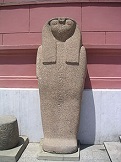
In 880 B.C.E. Shoshenq II's son Harsiese A (Hejkheperre Setepenamun) (d. -860), high priest of Amun in Thebes declares himself king of Egypt, founding the Twenty-Third (XXIII) (23rd) Egyptian Dynasty (ends -720), and splitting Egypt N-S.


In 872 B.C.E. Takelot I dies, and his son (by Kapes) Osorkon II (d. -837) becomes king #5 of the Egyptian 22nd Dynasty, ruling from Tanis, facing competition from his cousin Hariese A, who rules from Thebes, but soon dies, allowing Osorkon II to appoint his young son (by Djedmutesankh) Nimlot C as high priest of Amun in Thebes; meanwhile he appoints his young son Hornakht (Harnakht) as high priest of Amun in Tanis, who dies before age 10, and is buried in his tomb in Tanis.
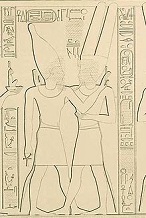
In 840 B.C.E. Nimlot C dies, and his son Takelot F (high priest of Amun in Thebes) becomes Takelot II (Hedjkheperre-Setpenre) (Se Ese = "Son of Isis") (d. -815), king #2 of the Egyptian 23rd Dynasty.
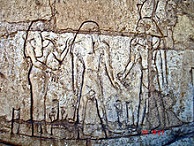
In 837 B.C.E. Osorkon II dies, and non-son Shoshenq III (Usermaatre Setepenre) (Setepenamum) (d. -798) becomes king #6 of the Egyptian 22nd Dynasty, ruling for 39 years.
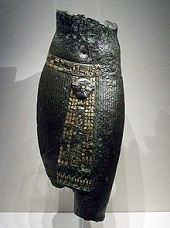
In 829 B.C.E. Pedubast (Pedubastis) I (d. -804) becomes king #3 of the Egyptian 23rd Dynasty, ruling for 25 years, going on to get in a long civil war with Takelot II, taking over in -815, after which he makes his son Iuput (Auput) I his co-regent, becoming king #4.
In 804 B.C.E. Pedubast I dies, and Shoshenq VI (d. -798) becomes king #5 of the Egyptian 23rd Dynasty, ruling from Thebes for six years.
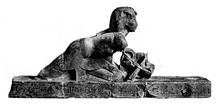
In 798 B.C.E. Shoshenq III dies, and his son Shoshenq IV (Hedjkheperre Setepenre) (d. -785) becomes king #7 of the Egyptian 22nd Dynasty. Shoshenq VI dies, and his son (by Karomama II) Osorkon III (d. -769), former high priest of Amun becomes king #6 of the Egyptian 23rd Dynasty, ruling 28 years.
In 785 B.C.E. Shoshenq IV dies, and (his son?) Pami ("He who belongs to the Cat Bastet") (d. -778) becomes king #8 of the Egyptian 22nd Dynasty.
In 780 B.C.E. Alara of Nubia (d. -760) founds the Kingdom of Napata in Kush (ends -656), becoming the first prince of Nubia, which goes on to conquer and rule Egypt.

In 778 B.C.E. Pimay dies, and his co-regent son (since -767) Shoshenq V (d. -740) becomes king #9 of the Egyptian 22nd Dynasty.

In 769 B.C.E. Osorkon III dies, and his eldest son and co-regent (since -774) Takelot III (Usermaatre) (d. -759) becomes king #7 of the Egyptian 23rd Dynasty.

In 760 B.C.E. Alara the Nubian dies, and (his brother?) Kashta the Kushite (d. -752) becomes prince #2 of Nubia, going on to conquer Egypt, becoming king #1 of the Egyptian Twenty-Fifth (25th) Dynasty (ends -656), ruling from Napata (250 mi. N of Khartoum) in Nubia (modern-day Sudan), installing his daughter Amenirdis I as the successor of Orsonkon III's daughter Shepenupet I, divine wife of Amun in Thebes.
In 759 B.C.E. Takelot III dies, and his younger brother (son of Osorkon III) Rudamun ((Usermaatre-Setpenamun) (d. -755) becomes king #8 (last) of the Egyptian 23rd Dynasty.
In 752 B.C.E. Kashta dies, and Piye (Piankhi) (d. -721) becomes king #2 of the Egyptian 25th Dynasty, ruling fom Napata in Nubia.
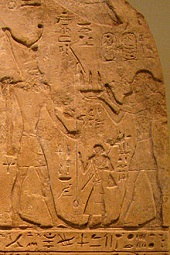
In 732 B.C.E. Shepsesre Tefnakht I (d. -725) becomes king #1 of the Twenty-Fourth (XXIV) (24th) Egyptian Dynasty (ends -720), calling himself "great chief of the west"; his descendants rule Egypt from Sais in the W Nile Delta for the next 139 years (until -588).
In 725 B.C.E. Tefnakhte I dies, and Bakenranef (Bocchoris) (d. -720) becomes king #2 (last) of the Egyptian 24th Dynasty based in Sais.
In 721 B.C.E. Piye dies, and Kashta's son (by Pebatjma) (Piye's son?) Neferkare Shabaka (Shabako) (Shabaqo) (d. -707) becomes king #3 of the Egyptian 25th Dynasty, going on to consolidate control of Egypt down to the Nile Delta, making Thebes his capital and initiating an enormous amount of construction while fending off the Assyrians under Sargon II; he leaves the Shabaka Stone, an attempt to preserve Old Kingdom history, which is later used as a millstone, defacing the hieroglyphics.
In 720 B.C.E. Pharaoh Shabaka captures Bakenranef, and has his bacon fried (burned alive), ending the Egyptian 24th Dynasty (begun -732); Shabaka reuinites Egypt.
In 712 B.C.E. a revolt against Assyria instigated by Egypt, led by King Iamanni of Ashdod followed by Judah, Edom, and Moab and Pi'ru of Musu is crushed; Pharaoh Shabaka gives asylum to Ashdod king Iamanni.

In 707 B.C.E. Shabaka dies, and his nephew (son of Piye) Shebtiku (Shebataka) (Shebitqo) (Djekare) ("Enduring is the soul of Ra") (d. -690) becomes king #4 of the Egyptian 25th Dynasty, going on to pursue a policy of conciliation with Assyria, extraditing king Iamanni of Ashdod, etc., until the reign of Sennacherib, when he flops and begins resisting Assyrian expansion.
In 701 B.C.E. a revolt by Sidon-Tyre, Escalon, Judah and Ekron supported by Egyptian Pharaoh Shebtiku causes the Assyrians to attack; Sennacherib defeats the Egyptians at the Battle of Eltekeh in S Palestine, then invades and conquers Phoenicia-Palestine to reinstate his ally Padi of Ekron; king Eluli of Tyre flees to Cyprus, and Sennacherib appoints Baal (Baalu) I (d. -660) as king of Tyre (until -660), then sieges and conquers the Israelite city of Lachish between Mt. Hebron and the maritime plain of Philistia (Johsua 10:3-5, 12:11), causing Sennacherib to order reliefs installed in his royal palace in Nineveh, showing an Israelite chariot, with the soundbyte "Sennacherib, king of the world, king of Assyria sat upon a throne and passed in review the booty from Lachish"; King Lule of Sidon flees to Cyprus; King Sidka of Ascalon is captured and sent to Assyria; about this time he defeats Arab tribal queen Iati'e (Yatie).
In 700 B.C.E. the Assyrians under king Sennacherib invade Judah, destroy many cities and siege Jerusalem after the Egyptians under future pharaoh Taharqa at Hezekiah's request stall their advance; the Assyrian gen. appeals to Jerusalem's pop. over King Hezekiah's head (Is. 36:4), and the Jewish officials plead with him not to speak in Hebrew, the language of (the) hoi poloi, but in Aramaic, the language of diplomacy understood by themselves (2 Ki. 18:26); the Assyrians claim a plague, and the Bible claims that it is Jehovah's angel slaying 185K of the cream of their warriors overnight (2 Ki. chs. 18-19, 32), but the Assyrians are turned back, yet only after making Hezekiah a vassal ("like a bird in a cage"), who has to pay a large tribute?
In 690 B.C.E. Shebtiku dies, and his cousin (Piye's son) Taharqa (Taharka) (Taharqo) (d. -664) becomes king #5 of the Egyptian 25th Dynasty,
In 677 B.C.E. Assyrian king (since -681) Esarhaddon (d. -669) invades Israel to pacifiy Arab tribes around the Dead Sea, chasing them to the Brook of Egypt (Nile River?).
In 674 B.C.E. Esarhaddon ends a revolt in Ashkelon, then invades Egypt, and is defeated.
In 671 B.C.E. Assyrian king Esarhaddon sieges Tyre, but it holds out, and he then defeats the Egyptian army, forcing it to retreat to Memphis, and "conquered it in half a day by means of mines, breaches, and assault ladders; I destroyed it, tore down its walls and burnt it down" (his own words), and establishes Assyrian rule in Egypt, becoming the last major territorial expansion of Assyria; Ramses XI is killed?; Pharaoh Taharqa flees S to Kush (Nubia), after which the capital of Kush (Nubia) moves to Meroe (Meroë) on the E bank of the Nile River near modern-day Shendi, Sudan 120 mi. NE of Khartoum; Kush becomes known as Ethiopia; Esarhaddon appoints 20 local princes to govern Egypt, led by Menkheperre Necho (Nekau) I (d. -664) in Sais; too bad, they can't obtain Egyptian loyalty to the hated Assyrians against the Nubians.
In 669 B.C.E. Taharqa returns and recaptures Memphis and massacres the Assyrian garrison; in fall after erecting a victory stele for his V in Egypt, and hearing of a revolt by Prince Ushankhuru, Esarhaddon dies while returning to Egypt.

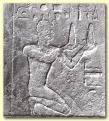
In 664 B.C.E. Taharqa dies, ending the 25th Egyptian (Kushite) Dynasty, and his son Tanutamun (Tenuatamum) (Tantamani) (Tandaname) (Tanwetamani) (Bakare) ("Glorious is the soul of Ra") (d. -656) becomes king #6 of the 25th Egyptian (Kushite) Dynasty at Napata; he kills Necho I and captures and sacks Thebes, causing Ashurbanipal to return and reconquer and raze it to the ground; the sacking of Thebes by Big Ashpan is considered a universally accepted fixed date of chronology; Necho I dies helping Tanutamun defend Lower Egypt from the Assyrians, and his son (by Istemabet) Psamtik (Psamtek) (Psammetichus) (Psammetikhos) I (Wah-Ib-Re) ("Constant is the heart of Ra") (d. -610) becomes king of Egypt (until -610), founding the Egyptian Twenty-Sixth (26th) Dynasty (ends -525), beginning the the 54-year-siege of Azotus (modern-day Ashdod) (ends -610), and going on to unite Egypt and free it from Assyrian control; the Third Intermediate Period (begun -1077) ends, and the Late Period of Ancient Egypt begins (ends -332), with foreigners ruling the country while Egyptian culture flourishes in its last gasp.
In Mar. 656 B.C.E. Psamtik I dispaches a naval fleet to Thebes that compels Kushite princess Shepenupet (Shepenwepet) II to adopt his daughter Nitocris I (d. -585) as her heiress as depicted in the 6' x 4.5' red granite Adoption Stela in Karnak (discovered in 1897 by Georges Legrain), ending the Nubian 25th Dynasty's control over Upper Egypt; Tanutamun dies after being driven from Egypt by the Assyrians, but the Kushite Kingdom of Napata continues.
In 655 B.C.E. Psamtik I rebels from Assyrian rule, aided by Carian and Ionian mercenaries sent by Gyges of Lydia, and gains control of all of Egypt, founding the Egyptian Twenty-Sixth (26th) (XXVI) Dynasty (ends -525), which rules from Sais, and enjoys a cent. of independence.
About 650 B.C.E. papyrus is used for written scrolls by the Egyptians; demotic (Gr. "popular") script, a cursive form of hieratic script written from right to left is developed, and used until the 5th cent. C.E.
In 645 B.C.E. Egyptian king Psamtik I recaptures what is left of Thebes from the Assyrians.

In 625 B.C.E. Chaldean king Nabopolassar (Naboplashar) (Nabu-Apla-Usur) (d. -605) becomes king of the Babylonians, founding the Neo-Babylonian Empire (ends -539); the term Chaldea (formerly only the region in S Babylonia bordering on the "Nether Sea" or Persian Gulf) becomes synonymous with all of Babylonia.

In 610 B.C.E. Psamtik I dies, and his son (by Mehtenweskhet) Necho (Nekau) (Neku) (Nechoh) (Nikuu) II Wahem-Ib-Re ("Carrying out the heart of Ra") (-658 to -595) becomes king #2 of the Egyptian 26th Dynasty (until -595); meanwhile the Median-Babylonian army marches on Harran, where his ally Ashur-Uballit II is holed-up, and he attempts to assist him, sending a small army which proves too small and retreats; meanwhile the 54-year siege of Azotus (Ashdod) by Egypt (begun -664) ends, becoming the longest siege so far in history.
In spring 609 B.C.E. Necho II leads a large army of mercenaries along the Via Maris coastal route ino Syria to help Ashur-Uballit II in Harran fight Babylonian conqueror Nabopolassar, but on the way he is intercepted by King Josiah of Judah at Megiddo, where Josiah is shot by an Egyptian archer in his war chariot (2 Chron. 35:20-25, 2 Ki. 23:29-30), and brought back to Jerusalem to die, after which Necho II sends messengers with the soundbyte: "What quarrel is there between you and me, O king of Judah? It is not you I am attacking at this time, but the house with which I am at war. God has told me to hurry; so stop opposing God, who is with me, or he will destroy you" (2 Chron. 35:21); after Nabopolassar captures Kumukh, cutting him off, Necho II goes on to capture Kadesh in Syria on the Orontes River, sending his battle clothes to Branchidae of Miletus, who dedicates them to Apollo; meanwhile Ashur-Uballit II flees Harran SW to Syria, hooking-up with Necho II and returning over the Euphrates (becoming the first pharaoh to cross it since Thutmose III) to siege Harran, but fail to capture it and retreat back to N Syria, after which Ashur-Uballit II vanishes from history, and Assyria is kaput, swallowed by the Babylonians, who annex Megiddo but leave it waste to get even for centuries of maltreatment; by popular acclaim Josiah's 4th and youngest son, 23-y.-o Jehoahaz (Joahaz) (b. -632) (Heb. "Jehovah has taken hold") (AKA Shallum) becomes king of Judah for 3 mo. (2 Ki. 23:29-31, 2 Chron. 36:2) and rules badly until Necho II imprisons him at Riblah and removes him in favor of his 25-y.-o. brother Eliakim, changing his name to Jehoiakim (-634 to -598) (Heb. "Jehovah raises up") (2 Ki. 23:34-6, 1 Chron. 3:15); his 11-year rule is marked by injustice and oppression, and raids from marauder bands; Jehoahaz is later taken to Egypt, where he dies in captivity (2 Ki. 23:31-4, Jer. 22:10-12); the Book of Hakkuk, warning of the coming wrath of God using the Chaldeans (Babylonians) to execute his judgment on Judah for their sins is written during his reign? During his Syrian campaign, Necho II begins building a canal linking the Pelusiac branch of the Nile River with the Red Sea (Erythraean Sea) (precursor of the Suez Canal), founding the city of Per-Temu Tjeku ("The House of Atum of Tjeku) in modern-day Tell el-Mashkuta 9 mi. W. of Ismalia, but stops it to go to war and never finishes it after 120K workers die trying to build it; after forming a navy using Ionian Greeks, Necho II's ships begin a 14-year circumnavigation of Africa from east to west.
In 608 B.C.E. Necho II retakes Kumukh after a 4-month siege, and executes the Babylonian garrison.
In 607 B.C.E. Babylonian king Nabopolassar and his son crown prince Nebuchadnezzar assemble independent armies; within a month the father goes back to Babylon, and his son successfully wars in mountainous territory, returning with much spoil.
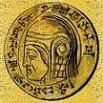
In summer 605 B.C.E. Babylonian crown prince Nebuchadnezzar (Nabuchodonosor) (Nabu-Kudurri-Usur) ("O god Nabu, preserve my firstborn son") II (d. -562) defeats the Egyptians under Necho II (his rival for control of Syria and Palestine) at the Battle of Carchemish (Karkemish) on the W Bank of the Euphrates River 400 mi. N of Jerusalem (Jer. 46:1-2) (35 mi. SE of Gaziantep in S Turkey on the Syrian border), and overtakes and annihilates the fleeing Egyptian army at Hama; both sides take heavy casualties, and Nabopolassar is KIA.
About 600 B.C.E. the first recorded circumnavigation of Africa by ships of Egyptian pharaoh Necho II (manned by Phoenicians) takes three years, sailing from the Red Sea around Africa, rounding the Cape of Good Hope heading W, noting that the Sun is to their right, then N to the Mediterranean, pausing each year to sow and harvest grain; Herodotus is later skeptical of this voyage, not knowing tha the Earth is spherical.

In 595 B.C.E. Nebuchadnezzar II conquers all of Phoenicia except Tyre; his army suffers serious losses while quelling a revolt. Necho II dies, and his son Psamtik (Psammetichus) (Psammeticus) II Neb-Ib-Re ("Beautiful is the heart of Ra") (d. -589) becomes king #3 of the Egyptian 26th Dynasty, going on to lead an expedition into Nubia in year 3 of his reign, reaching the 3rd or 4th Cataract and inflicting a heavy defeat on the kingdom of Kush, which loses its power to threaten Egypt, capturing Napata and forcing King Aspelta to move the capital S to Meroe (Meroë) near the 6th Cataract, founding the Kingdom of Meroë (Meroe) (ends 350 C.E.), with a pop. of 500K which worships the god Amun in the form of lion god Apedemak ("Lord of Royal Power"), and develops a unique building style; the rulers continue to be buried at Napata; too bad, Psamtik II fails to pursue them and retreats back to the First Cataract, leaving Elephantine as the S border of Egypt, contenting himself with defacing the monuments left by the Egyptian 25th Dynasty Kushite kings.
In 591 B.C.E. Pstamtik II of Egypt invades Palestine "to foment a general Levantine revolt against the Babylonians" incl. by King Zedekiah of Judah.

On Jan. 27 (Tebeth 10), 589 B.C.E. the Babylonians under Nebuchadnezzar II begin their Final Siege of Jerusalem, releasing Hebrew slaves on Sept. 29 (Tishri 1) at the beginning of the Hebrew Sabbatical year. In Feb. 589 B.C.E. Pstamtik II dies, and his son Apries (Wahibre Haaibre) (Waphres) (d. -567) (Hophra in Jer. 44:30) becomes king #4 of the Egyptian 26th Dynasty (until -570), going on to build the Palace of Apries in Memphis, along with temples at Athribis (Tell Atribis), Sais, and Bahariya Oasis.
In Oct. 588 B.C.E. after King Zedekiah allies with Egyptian Pharaoh Apries, who sends an army to protect Jerusalem, Nebuchadnezzar II lifts the siege of Jerusalem until he defeats them next Apr. in Phoenicia.
On Apr. 29 (Nisan 7), 587 B.C.E. after defeating the Egyptians Nebuchadnezzar II heads for Jerusalem, breaching the wall on July 29 (Tammuz 9) and capturing Zedekiah, who is brought to Big Neb blindfolded (2 Ki. 25:2-8), then retires to Riblah "in the land of Hamath", leaving the siege to his chief bodyguard Nebuzaradan ("Nebo has given offspring") (2 Ki. 25:8-12), who comes to Jerusalem 1 mo. later (Aug. 25) (Ab 7); on Aug. 28 (10 Ab) the Babylonians enter Jerusalem, wreck the wall, and loot the Temple of Jehovah (Solomon) (2 Ki. 25:8-20, Jer. 39:8-10, 43:5-6, 2 Chron.); the Ark of the Covenant is not there (captured by Pharaoh Shishak, or given by Solomon to the Queen of Sheba's son Menelik?); they capture and blind King Zedekiah, slaughter "all the nobles of Judah" (Jer. 39:1-8), and take the remainder of the pathetic Jews into the Babylonian Captivity, allowing some of the lowliest ones to remain; on the 10th day of Ab Nebuzaradan inspects and then burns the temple (on the same day that the rebuilt temple is burned in 70 C.E.) (the Jews commemorate the 7th day of Ab with a fast, and also celebrate the 9th day of Ab, or Tishbah b'Ab); Nebuzaradan releases the prophet Jeremiah from the nasty old cistern where he had been thrown by royal princes Gemariah, Jucal (Jehucal) et al., gives him supplies, and appoints Gedaliah as gov. over those remaining (2 Ki. 25:22, Jer. 39:11-14, 40:1-7, 41:10); the kingdom of Judah ceases to exist, becoming a province of Babylonia, and never again does a king rule in Jerusalem; in 2005 Israeli archaeologist Eilat Mazar et al. find a .04-in. clay seal on the site of the palace which reads "Belonging to Yehuchal son of Shelemiyahu son of Shovi"; another seal contains the name Gemariah, son of Shaphan, the 1st royal minister, Yehuchal being 2nd.

In 586 B.C.E. Egyptian Pharaoh Apries gets his sister (daughter of Psamtik II and Takhuit) Ankhnesneferibre (d. -525) adopted as the wife of Amun in Thebes; meanwhle his big D in Judah causes a mutiny of his garrison in Awan, which he puts down.

In 570 B.C.E. after they begin invading Libya, Pharaoh Apries sends an army against the Dorian Greek city of Cyrene, and it is soundly defeated, the news causing a civil war to break out between native troops and foreign mercenaries, after which Apries flees, and gen. Ahmose (Amasis) II ("the Moon is born, son of Neith") (d. -526) (victorious gen. in the -592 Nubian invasion) becomes king #5 of the 26th Dynasty, and the last great pharaoh of Egypt before the Persians swallow it up.
In 567 B.C.E. the Saites defeat another Babylonian invasion of Egypt led by ex-pharaoh Apries, who is KIA, and Ahmose II has his body buried in Sais with "full military honors", and marries his daughter Chedebnitjerbone II (Nitetis?) to legitimize his rule.
In 526 B.C.E. Amasis III dies, and Psamtik (Pstamtek) III becomes king #6 (last) of the Egyptian 26th Dynasty, ruling for 6 mo.
In May 525 B.C.E. after Cambyses II kills his brother Smerdis (Bardiya) to ensure the throne of Persia, but makes a big mistake by keeping it secret, then leads a campaign to capture Egypt, the last remaining independent kingdom in the East, which is just too sexy for him to pass up, he defeats the Egyptians at the Battle of Pelusium, causing them to retreat to Memphis and surrender after a siege; Cambyses II gets on his horse before Peluseum and tosses cats (their sacred animal) into the air to taunt them (were they those Egyptian Mau cats with gooseberry green eyes?); Psamtik III is captured and carried off in chains to Susa to be executed; Egypt down to but not incl. Meroe is conquered by the Achaemenid Persians, who destroy many Egyptian temples and establish the get-down Twenty-Seventh (XXVII) (27th) Dynasty (First Egyptian Satrapy), which rules Egypt with an iron hand as a satrapy (until -404), beginning the First Persian Occupation (ends -404); foreigners dominate Egypt for the next 2.5K years (until 1952); an unsuccessful attempt is made to conquer the Kushite kingdom of Meroe at the Sixth Cataract; too bad, a sandstorm in the W Egyptian desert buries 50K Persian warriors sent to attack the oasis of Siwa and destroy the oracle at the Temple of Amun, whose priests refuse to accept his claims to rule Egypt; their remains are found in 2010; they really were ambushed and defeated by Egyptian rebel leader Petubastis III?; the same oracle later confirms that Alexander the Great is the divine son of Zeus (Amun) in -332.


In 522 B.C.E. after Sparta deposes the tyrant of Naxos, the Magian (Persian subject people) Artaxerxes (Bardiya) (Gaumata), claiming to be Cambyses II's brother Bardiya (who nobody knows is dead except Cambyses II) claims the throne for 7 mo., until the news reaches the real Cambyses II, pissing him off and causing him to gather his army in Egypt and head for Persia; too bad, he dies in the summer while camped in Syria either by suicide or by an accident while mounting a saddle; in Oct. Nebuchadrezzar III (Nabu-Kudduri-Usur) (real name Nidintu-Bel), claiming to be the son of Nabonidus seizes the Babylonian throne until Dec., when Gen. Darius (Darayavaush) I the Great (-549 to -485) defeats him on the Tigris River; meanwhile Gaumata is executed by six nobles in Nisaia in Media, then allegedly receives a favorable oracle declaring him king and assumes the throne (even though he is from another branch of the Achaemenid family, and his father and grandfather are still alive); meanwhile 4 days later revolts begin in Assina in Elam and Nidintu-Bel in Babylon, spreading to Persia itself after Vahyazdata, another Bardiya pretender pops up, causing Darius I to marry Cambyses' wife-sister Atossa to solidify his claim, then win 19 battles in one year to solidy his reign, after which he goes on to reorganize the admin. and establish the first (20) Persian satrapies, and codify the laws for the sprawling empire of 20 countries, which eventually incl. the former realms of the Egyptians, Chaldeans, Ionians, Persians, and Medes, and stretches from the Mediterranean to the Indus Valley, and S into Africa (Libya), becoming the largest ever, with a pop. of 15M-16M, incl. 4M in Persia; royal residences are at Susa (at the E end of the Persian Royal Road, which runs through Gugamela and Harran to Sardis in Lydia), Persepolis (in S Persia 200 mi. SE of Susa), Ecbatana (100 mi. N of Susa) and Babylon (100 mi. W of Susa); Armenia is the 13th Persian satrapy; he introduces a standard gold coinage, the Achaemenid Daric to go with the silver Siglos, becomes the first emperor in Europe, trying to portray himself as backed by God, protecting the weak and meting out justice; Darius I brings Egypt under his rule, and order the finishing of the canal linking the Nile River at Bubastis with Suez, allowing his ships to sail through the Red Sea by Saba to Persia, making it wide enough for two triremes to pass each other with extended oars, with a 4-day time of passage (cry me a river?); Darius I orders the construction of the new capital city of Persepolis in the S Zagros Mts. in SW Persia (NE of modern-day Shiraz); he erects the Behistun Rock, a commemoration of his achievements in three parallel sets of Old Persian, Elamite, and Akkadian cuneiform (413 lines), placed prominently on the way into the city, harping about his being the lawgiver and justice dispenser, and portraying him holding a bow (symbol of wisdom and strength), becoming the first political billboard and political logo?; in modern times it becomes the Rosetta Stone for cuneiform.
In 404 B.C.E. Amyrtaeus (Amyrtaios) (Amenirdisu) of Sais (d. -399), a relative of the 26th Egyptian Dynasty royal family revolts against the Persians, ending the First Persian Occupation (begun -525), and becomes the one and only ruler of the Egyptian 28th (XXVIII) Dynasty (ends -398).
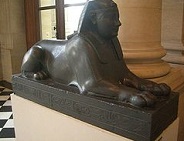
In 398 B.C.E. after defeating Amyrtaeus and executing him in Memphis last Oct., Nepherites (Nefaarud) I (d. -393) of Mendes (Djedet) (modern-day Tell El-Ruba) in the E Nile Delta becomes king #1 of the Egyptian 29th (XXIX) Dynasty (ends -380), going on to support Sparta in its war against Persia, sending them 500K measures of grain and material for 100 triremes; a gift sent to the Spartans is swiped as the ships pass Rhodes, which has defected to the Persian side - the first Rhodes scholarships?

In 393 B.C.E. Nepherites I dies, and next year usurper Psammuthes (Pasherienmut) (d. -391) seizes power from his son Hakor, becoming king #2 of the Egyptian 29th Dynasty

In 392 B.C.E. Nepherites I's son Hakor (Hagar) (Achoris) (Hakoris) (d. -380) overthrows Psammutes, becoming king #3 of the 29th Egyptian Dynasty.
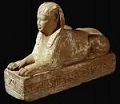
In 380 Hathor dies, and his son Nepherites (Nefaarud) II (d. -380 becomes king #3 of the Egyptian 29th Dynasty, ruling only 4 mo. until army gen. Nectanebo (Kheperkare Nakhtnebet) I (d. -360) of Sebennytos overthrows him, becoming king #1 of the Egyptian 30th (XXX) Dynasty (ends -343) (last dynasty with Egyptian-born rulers), and successfully turns back the Persians, building a great Temple of Isis on Philae, an island in the Nile (closed 537 C.E.), causing the cult to spread throughout the Hellenic world in this cent.; Isis (later identified with the Greek goddess Demeter) is the daughter of the Earth and Sky (Keb and Nut), wears cow horns, has the personality of Athor (goddess of love and gaiety), marries her brother Osiris (Serapis) (judge of the dead), and has son Horus (god of day) - the original Hollywood couple?
In 374 B.C.E. Persia unsuccessfully invades Egypt; about this time Persians finally give up putting their retro cuneiform on monuments (begun -570).
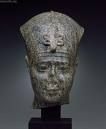
In 360 B.C.E. Nectanebo II (d. -343) becomes the 3rd and last ruler of the Egyptian 30th Dynasty; Persia attacks, and he flees to Ethiopia.
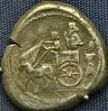
In 343 B.C.E. Persian king (since -358) Artaxerxes III Ochus (-425 to -338) reduces Sidon, conquers Egypt, and becomes the first (only) ruler of the Egyptian Thirty-First (31st) (XXXI) Dynasty (ends -332); 60 years of independence for Egypt ends, along with the New Kingdom - but the Isis-Osiris-Horus show goes on tour and breaks box office records?


In Jan. 332 B.C.E. blonde-blue Macedonian king (since -336) Alexander III the Great (-356 to -323) sieges the well-protected island city of Tyre under its last king Azemilkos, and captures it in Aug. after a 7-mo. siege by building an enormous mole connecting it permanently with the mainland, during which time he goes underwater in a diving bell to observe divers removing underwater obstacles, and has his vessels equipped with chain cables so that they couldn't be cut adrift at night; he crucifies 2K POWs and sells 30K more into slavery; the Persian navy disintegrates, and Phoenician trade slackens as the Phoenicians lose their identity and are Grecianized; Alexander then obtains the submission of the provinces of Galilee, Samaria and Judah, and invades Egypt, and Persian satrap Mazaces surrenders without a fight, ending the 31st Egyptian Dynasty (begun -343); Alexander stay in Egypt for a year, visiting the Egyptian coast and ordering the Temple of Luxor restored to its ancient glory, then having an overwhelming desire to found a new city (according to Roman author Arrian), which becomes Alexandria, then visits the Oracle of Amon-Ra at the Siwah Oasis in the Western Desert (barely making it and almost dying of thirst), where is proclaimed the son of god; the Late Period of Ancient Egypt (begun -664) ends; there were settlements in the Alexandria area for several hundred years? According to Jewish historian Josephus in his Antiquities 11.317-45, Alexander III the Great visits Jerusalem, and the Jewish elders freak him by reading to him from the Book of Daniel (Ch. 2) the prophesy about the statue with a head made of gold, chest and arms made of silver, belly of brass, legs of iron, and feet of iron mixed with clay, explaining that the head is Babylon, the breast and arms Medo-Persia, the brass belly and thighs Greece, and the iron legs Rome, before or after which he has a dream about the Jewish god being right and sacrifies to him, sparing the city from sacking although putting it under his control; they probably didn't read to him from Ch. 8, which talks about the shaggy goat with one large horn between its eyes that is replaced by four horns that have lesser power?; too bad, the pop. of Gaza puts up a fight at a stronghold on a hill, causing Alexander to siege and take it in Oct. after suffering a serious shoulder wound, massacring the men and selling the women and children into slavery.
On Apr. 7, 331 B.C.E. the city of Alexandria on the Cape Lochias peninsula, protected by the island of Pharos is founded by Alexander III the Great, with Cleomenes of Naucratis (d. -322) as gov. #1; a number of Jews settle there immediately - and begin churning out the New Testament?


In 305 B.C.E. Alexander III the Great's polymath gen. Ptolemy I Soter (Gr. "savior") (-367 to -283), son of Lagus takes power in Egypt, becoming king #1 of the Hellenistic Egyptian Thirty-Second (32nd) (Ptolemaic) (Lagid) Dynasty, which lasts 275 years (until -30); Ptolemy I establishes the great Alexandria Museum-Library (Museo) (dedicated to the Muses) in Egypt in honor of Alexander III the Great, whose body he had brought from Babylon and buried there; elite Greek scholars must complete the Logikon, a course in theoretical science before going on to the Cheirourgikon (experimental lab), incl. an observatory, botanical-zoological gardens, dissection rooms, et al.; the library is filled by royal decree, with all travelers visiting the city required to yield up any scrolls in their possession so that copies can be made and given to them; the museum cranks out pioneers incl. Euclid of Alexandria (-365 to -265) (geometry), Herophilus (Herophilos) (-335 to -280) (anatomy), Aristarchus of Samos (-310 to -230) (astronomy), Eratosthenes of Cyrene (-276 to -194) (astronomy), Hero (Heron) of Alexandria (10-70) (steam turbine and windmill-driven organ) et al.; destroyed in 642 C.E. by the Christians, er, Muslims.
In 285 B.C.E. Ptolemy I's son Ptolemy II Philadelphus becomes co-regent of Greek-run Egypt.
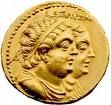
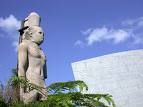
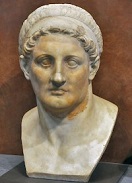
In 283 B.C.E. Macedonian Greek gen. Ptolemy I (b. -367) dies after telling Euclid of Alexandria that his Elements is too hard to study and receiving the reply "There is no royal road to geometry", leaving History of the Conquests of Alexander; after a catfight between his 3rd and 4th wives Eurydice (daughter of Antipater of Macedon) and Berenice I, his co-regent (since -285) son Ptolemy II Philadelphus (-309 to -246) (Berenice I's son) becomes king #2 of the Egyptian 32nd (Ptolemaic) Dynasty, sole ruler of Egypt and Libya, and is crowned next Jan. 7, pissing-off Euyrice's son Ptolemy Keraunos (Ceraunus) ("thunderbolt") (d. -279) (ceramic anus?), who had grown up thinking he would be Ptolemy I's heir, causing him to move to the court of Lysimachus, king of Macedonia, Thrace, and W Asia Minor, whose wife Arsinoe II is his half-sister.
In summer 282 Seleucus I begins preparing his army after Arsinoe II poisons her hubby Lysimachus' mind against his son and intended heir Agathocles and gets him to order his execution, and Agathocles' wife Lysandra and her brother Ptolemy Keraunos flee to his court in Babylon, asking for aid to place a son of Agathocles and Lysandra on the throne.

In Feb. 281 B.C.E. after appointing his son Antiochus as his successor, Seleucus I (b. -358) defeats and kills Lysimachus (b. -361), ruler (since -306) of Thrace, Macedonia, and Asia Minor at the Battle of Corupedion (Corupedium) in Lydia near Magnesia ad Sipylum, winning all of Asia Minor and proclaiming himself king of Macedon; in Aug.-Sept. after crossing the Hellespoint en route to seizing Thrace and Macedonia, Seleucus I is treacherously assassinated (stabbed) by Ptolemy Keraunos, disinherited son of Ptolemy I Soter, earning him the nickname "thunderbolt", and Seleucus I's son Antiochus I Soter ("savior") (-324 to -261) becomes king of Syria, while Keraunos takes Macedonia (until -279), beginning the First War of Succession (ends -279) with Ptolemy II Philadelphus, who hires an army of 4K Celtic warriors from the Balkans with the help of Antigonus II Gonatus.
About 280 B.C.E. the Gallic invasion of the Balkans sees an 85K-man army of Celtic Gauls from overpopulated Pannonia led by Cambaules and Brennus ("duke") (Acichorius?) (d. -279) invade the Balkans, reaching N Bulgaria next year before splitting into three groups, with Brennus' group invading Paionia (Paeonia) N of Macedonia, group #2 led by Cerethrius, Leonnorius and Lutarius invading Thrace and Triballi, and group #3 led by Bolgius (Bolgios) (Belgius) invading Macedonia and Illyria.
In spring 279 B.C.E. after they offer Ptolemy Keraunos the chance of paying them to keep them from attacking, and he underestimates them and turns down an offer of 20K soldiers from the Dardanians, then refuses to aid the tribes of Thrace against them, causing them to switch sides, the Celtic Gauls of Bolgius invade Macedonia and kick Ptolemy II's Keraunos' ceramic anus and capture and behead him after he is thrown by his his elephant, parading his head around on a spear, leaving Macedonia in anarchy, with rulership claimed successively by Keraunos' brother Meleager, Antipater Etesias, and Sosthenes; the First War of Succession in Syria (begun -280) ends by default; too bad, the Gauls don't follow-up their V in Macedonia, and Macedonian gen. Sosthenes (d. -277) assembles an army that forces Bolgius' troops to withdraw, only to be defeated by more Gauls under Brennus, after which 30K Gauls under Brennus defeat the Greeks at the Second Battle of Thermopylae after being held back for several mo., but are turned back at the Battle of Delphi after the Greek gods allegedly send them bad weather and the Celts go mad and slay 26K of each other; Brennus dies of his wounds, while his army retreats to the Spercheios River, only to be routed by an army of Thessalians and Malians; Arsinoe II flees to Alexandria after Ptolemy II Philadelphus executes her two younger sons.
In 279 Ptolemy II takes Miletus in SW Asia Minor from Antiochus I, and donates a large plot of land to it to cement their friendship.
In 278 B.C.E. Ptolemy II explores the Upper Nile River, then crosses over the Red Sea into N Arabia to establish commercial routes.

In 277 B.C.E. Arsinoe II gets Arsinoe I, wife of her brother Ptolemy II exiled, then marries him herself, gaining them both the title "Philadelphoi" (Philadelphus) (brother or sister loving); an iron lady, she becomes a virtual co-pharoah - set the stage to mix and mingle? The moral of the story is clear, when you want milk and chocolate, make it Two Musketeers?
In 277 B.C.E. an army of 20K Gauls led by Leonnorius et al. siege Byzantium and force them to pay tribute, gaining control of Lysimachia; they then luck out when Nicomedes I of Bithynia allies with them in an effort to rid his kingdom of his pesky brother Zipoites II, and helps them cross into Asia Minor to defeat and kill the pest, allowing Big Nick to become sole ruler of Bithynia; the Gauls then advance into Phrygia and colonize Galatia in the Kizil Irmak and Delice Irmak River basins on the great central plateau of Asia Minor, with capital at Ancyra (modern-day Ankara) (225 mi. ENE of Byzantium), mixing with a gaggle of Greeks and raising sheep and goats; meanwhile back in Macedonia, Antigonus II Gonatas defeats the Gauls under Cerethriius at the Battle of Lysimachia, and recovers Macedonia from the "wild men", establishing the Antigonid Dynasty (ends -168); the defeated Gauls move inland to Thrace and establish a kingdom with capital at Tyle (Tylis) (modern-day Kazanluk) (ends -211) - Spartacus' great-great-?-grandfather might be a Celt?

In 275 B.C.E. the Pharos Lighthouse in Alexandria harbor (begun -290) is completed by Ptolemy II, becoming the world's first important lighthouse, guiding ships into the harbor for 1.5K years before being toppled by an earthquake in 1323 C.E.

About 275 B.C.E. Egyptian high priest Manetho writes History of Egypt (Aegyptiaca) (3 vols.) in Greek, becoming the first to divide rulers into dynasties.
In 270 B.C.E. Egyptian king Ptolemy II Philadelphus hires an army of 4K Celtic warriors from the Balkans with the help of Antigonus II Gonatus, but after arriving in Egypt they begin plotting to take over, causing them to be captured and exiled on a deserted island in the Nile River, where they are starved to death.

On Jan. 29, 246 B.C.E. Ptolemy II (b. -285) dies, and his son (who as crown prince has already put down a revolt in Cyrenaica) Ptolemy III Euergetes ("benefactor") I (d. -222) becomes king #3 of Egypt's 32nd (Ptolemaic) Dynasty, and soon receives an urgent call for help from his sister (Antiochus II's 2nd wife) Berenice II, who is under siege by Laodice I, beginning the Third Syrian (Laodicean) War (War of Berenice) between Ptolemy III and Seleucus II (ends -241); Berenice II and her infant son are murdered in Antioch before Ptolemy III arrives in Asia Minor, taking Antioch, then moving E to take Babylon and Seleucia-on-the-Tigris.
In 239 B.C.E. the leap year is introduced into the Egyptian calendar.
In 238 B.C.E. a great assembly of priests is held in Canopus, Egypt, leaving the Table of Canopus (Canopus Stone) (Decree of Canopus), which serves as a double-check on the trans. of the Rosetta Stone; discovered in 1866 by Prussian Egyptologist Karl Richard Lepsius.
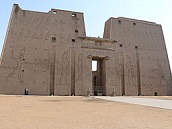
On Aug. 23, 237 B.C.E. the Egyptian Temple of Horus at Edfu on the W bank of the Nile River in Upper Egypt is begun (finished -57).
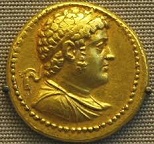
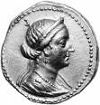
In 221 B.C.E. Ptolemy III Euergetes dies, and his fat lazy son Ptolemy IV Philopator ("father loving") (d. -204) becomes king #4 of Egypt's 32nd (Ptolemaic) Dynasty, imprisoning Cleomenes III; the Eyptian Ptolemaic Dynasty peaks and goes down under this weak king dominated by his chief minister Sosibius, who has his mother, uncle, and younger brother killed while he becomes addicted to orgiastic practices of religion and lit. dilettantism, building a temple to Homer and marrying his sister Arsinoe III Philopator (-246 to -204) while being pussy-whipped by his mistress Agathoclea (-247 to -202), sister of his minister Agathocles (-202).
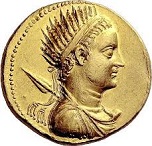
In summer 204 B.C.E. after building the huge Tessarakonteres ("forty") galley (largest human-powered vessel ever built), Ptolemy IV is murdered along with his wife Arsinoe III (b. -246) in a palace coup led by Philopater's two most powerful ministers Sosibius and Agathocles, who become regents for Ptolemy IV's 5-y.-o. son Ptolemy V Theos Epiphanes (Gr. "god manifest") (-210 to -181), who becomes king #5 of Egypt's 32nd (Ptolemaic) Dynasty, going on to lose most of Egypt's territories in the Aegean and Asia Minor; his coronation is the event described on the Rosetta Stone (-196); too bad, Agothocles soon kills Sosibius, causing the Egyptians and Greeks of Alexandria to rise against him, causing him to hole-up in the palace until his friends mercy-kill him, after which his father Agathocles, mother Oenanthe, and her sisters are dragged out by the mob, stripped naked, and torn limb from limb.
In 200 B.C.E. Antiochus III of Syria wins the Battle of Panion (Panium) (Paneas) (named after the Greek god Pan) at the foot of Mt. Hermon N of the Golan Heights at the source of the Banias River, chasing the Ptolemies out of the Holy Land (Palestine and S Syria), then seizes Coele-Syria and most of S Asia Minor except Cyprus; the Fifth Syrian War (begun -202) ends after Ptolemy V agrees to marry Antiochus II's daughter Cleopatra I; he doesn't give up his claim to Syria but ends up being assassinated in -180 before he can do anything about it?
In 198 B.C.E. Syria becomes part of the Seleucid Empire, and Palestine reverts to Syria; Egypt is out of the Judean picture.

In 196 B.C.E. the black basalt Rosetta Stone is cut, containing parallel texts in Egyptian Hieroglyphics, Egyptian Demotic, and Greek, celebrating the coronation of Ptolemy V Epiphanes, who is married to Cleopatra I, daughter of Antiochus II; discovered in July 1799 by the French under Napoleon.
In 189 B.C.E. exorbitant taxes cause insurrections in Upper Egypt.

In 181 B.C.E. Ptolemy V Epiphanes (b. -210) is assassinated, and his 6-y.-o. son Ptolemy VI Philometor ("loving his mother") (-185 to -145) becomes king #6 of the Egyptian 32nd (Ptolemaic) Dynasty, with his mother Cleopatra I Syra (-204 to -176) as regent.
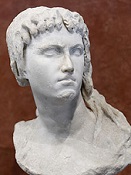
In 176 B.C.E. Cleopatra I dies; Eulaeus and Lenaeus become Ptolemy VI's guardians; his sister Cleopatra II (-185 to -116) becomes his wife, going on to have children Ptolemy Eupator, Cleopatra Thea, Berenice, and Cleopatra III.
In 170 B.C.E. the Nubian language of Meroitic begins to be written; still undeciphered?
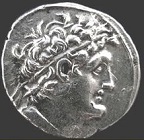
In 168 B.C.E. Antiochus IV invades Egypt, and Ptolemy V's cowardice in the war causes the regents to put his younger brother Ptolemy VII Neos Philopator ("father lover") (d. -145) on the throne to rule jointly with him and his sister-wife Cleopatra II; despite his friendliness toward Rome, the Romans "draw a line in the sand" and force Antiochus IV to withdraw, ending the Sixth Syrian War (begun -170); Antiochus IV makes young Ptolemy VI his ward.
In 164 B.C.E. Ptolemy VI of Egypt is expelled by his brother Ptolemy VII.
In 163 B.C.E. the Roman Senate restores Ptolemy VI and gives the W province of Cyrenaica (Cyrene and Cyprus, the latter known for its licentious worship of Aphrodite) to Ptolemy VII, splitting Egyptian rule; Ptolemy VII only secures Cyrene.

In 154 B.C.E. 10-y.-o. 10-y.-o. Cleopatra Thea ("goddess") Euergetis ("benefactress") (-164 to -121) becomes engaged to her uncle Ptolemy VIII, king of Cyrene, but he ends up marrying her mother (his sister) Cleopatra II.
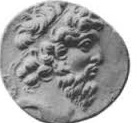

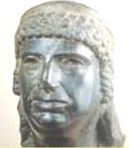
In July 145 B.C.E. debauched Alexander Balas is defeated in Antioch by Demetrius I Soter's son Demetrius II Nicator (Gr. "conqueror") (-160 to -125), who in Sept. becomes king of Syria (until -138), immediately facing several usurpers while Ptolemy VI Philometer marries his daughter (Balas' old wife) Cleopatra Thea, and dies a few days later from wounds sustained in the fighting, and his 16-y.-o. son Ptolemy VII Neos ("new Dionysos") Philopator (Philopater) ("father lover") becomes king #7 of Egypt's 32nd (Ptolemaic) Dynasty, with his mother Cleopatra II as regent; his uncle Physcon then marries her and murders him during the wedding feast, assuming the throne as Ptolemy VIII Euergetes ("benefactor") II Physcon ("fat bellied") (-182 to -116), becoming king #8 of Egypt's 32nd (Ptolemaic) Dynasty: he then marries Cleopatra II's daughter (his niece) Cleopatra III (-161 to -101), who becomes the main player; meanwhile Demetrius II Nicator attacks the Egyptian army - the spark happens?
In 145 B.C.E. in response to the desecration of the Temple of Jerusalem under Antiochus IV Epiphanes and the supplanting of the legitimate line of Jewish priests by the installation of Alcimus, a Jewish temple is founded in Leontopolis (Gr. "city of the lions") in the Nile Delta, which becomes known as the Land of Onias; it is presided over by priests of the family of Onias IV, and it becomes the only Jewish temple outside of Jerusalem where sacrifices are offered.
In 131 B.C.E. Cleopatra II revolts against Ptolemy VIII and expels him and Cleopatra III from Egypt, causing Ptolemy VIII to hole-up in Cyprus and murder his stepson Ptolemy and his son Ptolemy Memphites, and have the latter's dismembered head, hands, and feet sent to her in Alexandria as a birthday present; Cleopatra II rules Egypt until -127.
In 127 B.C.E. Cleopatra II is forced by Ptolemy VIII to flee to Syria, joining her daughter Cleopatra Thea and son-in-law Demetrius II Nicator.



In 116 B.C.E. Ptolemy VIII Physcon dies, leaving power to Cleopatra III and any of his sons she might prefer, leaving Cyrene separately to his son Apion, and Cyprus to his son Ptolemy X Alexander I (-107 to -88), who vies for the throne with his other son Ptolemy IX Soter II Lathyrus (Lat. "chick pea") (d. -81); Cleopatra III expels Ptolemy X, and Ptolemy IX becomes king #9 of Egypt's 32nd (Ptolemaic) Dynasty as her co-regent; he marries his sister Cleopatra IV (-138 to -112), but mommy disapproves and replaces her next year with younger sister Cleopatra Selene I (-135 to -69) - kissy and scratchy, I like that?
In 110 B.C.E. after claiming that he tried to kill her, Cleopatra III deposes her son Ptolemy IX Lathyrus and replaces him with Ptolemy X Alexander I, but grows tired of him and reverses the choice next year, then reverses the choice again in 107 B.C.E.
In 101 B.C.E. Ptolemy X Alexander I murders his mother Cleopatra III and rules Egypt alone (until -88).
In 90 B.C.E. Socrates the Good (Chrestus), brother of Nicomedes IV of Bithynia allies with Mithridates VI the Great of Pontus and kicks his bro's butt, causing him to flee to Rome, after which the Romans intervene and restore him.
The original National Greekographic? In 90 B.C.E. Greek Stoic polymath philosopher-historian Posidonius "the Athlete" of Apamea (-135 to -51) sets out on a mission to visit the "wild" Celts of the forests and mountains of W Europe, producing his History of the Wild Celts (later lost), which becomes a Roman bestseller; he says that the Celts are sophisticated people who perform highly ritualized human sacrifice, compose beautiful poetry, and give their Celtic women greater freedom than even the Romans (incl. the right to be a warrior), and falsely claims that they are cannibals; Caesar reads it and now knows what his life work will be, namely, to kill or enslave them all and steal everything they've got to make himself a millionaire and big man who's spread civilization to the less fortunate?; once nice thing, the Celts have no written language, so the survivors won't later stink Rome up with bestselling exposes?

In 88 B.C.E. the people of Alexandria expel Ptolemy IX Alexander I for having too close ties with the Jews, and restore his exiled brother Ptolemy IX Soter II Lathyrus (d. -81), who in Oct. defeats Ptolemy X Alexander and becomes the 10th king of Egypt's 32nd (Ptolemaic) Dynasty (until -80); Ptolemy IX then marries his daughter Cleopatra Berenice III (-120 to -80) to legitimize his rule, and in Dec. he defeats and kills Gen. Chaereas.
In Dec. 81 B.C.E. Ptolemy X Alexander dies, and his daughter-wife Cleopatra Berenice III (-120 to -80) (daughter of Ptolemy IX Lathyrus and Cleopatra Selene I) becomes king #11 of Egypt's 32nd (Ptolemaic) Dynasty (until -80); Ptolemy IX reclaims the throne, but dies at the end of the year, and she goes on to rule for 6 mo., becoming popular with the people.


In 80 B.C.E. Roman gen. Sulla appoints Ptolemy XI Alexander II (d. -80) as king #12 of Egypt's 32nd (Ptolemaic) Dynasty, and his older stepmother Cleopatra Berenice II is forced to marry him, but 19 days later he murders her, causing an angry Alexandrian mob to lynch him, and Ptolemy IX's llegitimate son (by an Alexandrian Greek concubine) Ptolemy XII Neos Dionysos Theos Philopator Auletes (Gr. "flute player") Nothos (Gr. "bastard") (-117 to -51) becomes king #13 of Egypt's 32nd (Ptolemaic) Dynasty (until -58), marrying his sister Tryphaena, who becomes Cleopatra V Tryphaena (-95 to -57).






In 69 B.C.E. Julius Caesar is elected quaestor for Spain; meanwhile his future sugar britches love babe Cleopatra VII is coming out of the chute, while Ptolemy XII deposes Cleopatra V and becomes sole ruler, bribing the Romans to keep Egypt from being annexed - I picked up all the garbage and checked off all the names?
In Sept. 58 B.C.E. after riots in Alexandria, Ptolemy XII Auletes flees to Rome with Cleopatra VII to seek military aid, and his wife Cleopatra V Tryphaena rules Egypt jointly with their daughters (sister of Cleopatra VII) Berenice IV Epiphaneia (-77 to -55) and Cleopatra VI Tryphaena (until -55); in 57 B.C.E. Berenice IV is forced to marry Seleucus VII Kybiosaktes ("tuna fish gutting work"), but soon has him strangled, ditches Cleopatra V and Cleopatra VI and rules alone, then marries high priest Archelaus, alleged son of Mithridates VI of Pontus, but doesn't share royal power.
In July 55 B.C.E. after bribing Roman gov. of Syria Aulus Gabinius and agreeing to support Pompey, who is in Alexandria in Mar., Ptolemy XII Auletes returns to Alexandria with some Roman troops and kicks Berenice IV's butt and has her beheaded after her hubby Archelaus is KIA.
In 52 B.C.E. Ptolemy XII Auletes makes Cleopatra VIII his co-ruler.






In Feb.-Mar. 51 B.C.E. Ptolemy XII Auletes (b. -17) dies, leaving Egypt jointly to his 11-y.-o. son Ptolemy XIII Theos Philopator (-62 to -47), who marries his 18-y.-o. daughter Liz, er, Cleopatra VII Philopator ("father-loving") (-69 to -30), "the Serpent of the Nile", who becomes king #14 of Egypt's 32nd (Ptolemaic) Dynasty and the 7th and most famous queen of ancient Egypt; she doesn't officially accept her brother until next summer - an 18-y.-o. bitchin' babe does what with her preteenie brother?

In 49 B.C.E. both Julius Caesar and Ptolemy recognize Ptolemy XIII as sole ruler of Egypt, with Cleopatra VII remaining queen in Thebaid, and her other brother Ptolemy XIV (-60 to -44) as co-ruler.


On Jan. 4, 48 B.C.E. Julius Caesar, having crossed the Adriatic Sea to attack Pompey lands and occupies Oricum and Apollonia in Illyria; on July 10 after Caesar tries to encircle Pompey's position with a series of forts, the Battle of Dyrrhachium sees Pompey's 30K men (mainly new recruits) defeat Caesar's 10K men; too bad, Pompey balks at pursuing Caesar's fleeing troops, believing it's a trap, causing lucky Caesar to utter the soundbyte: "Today the victory had been the enemy's had there been any one among them to gain it"; Caesar withdraws toward Thessaly, with Pompey finally pursuing him, letting Caesar pick his own ground, while Pompey's officers pressure him to attack rather than let them surrender from hunger and exhaustion; on Aug. 9 the Battle of Pharsalus N of the Epineus River in S Thessaly sees Pompey lead nine Roman legions and a force of Greek and Macedonian cavalry, while JC has no cavalry and is outnumbered 2-1, but the tough veteran infantrymen pull the horses around to attack the riders, and eventually Pompey's legions cut and run, 15K falling in battle, until Pompey watches Caesar's soldiers raid his camp, and utters the soundbyte "In the very camp?", deciding to phar-salus to Egypt, hoping to beg Ptolemy XII for refuge, while the rest of his soldiers surrender on Aug. 10; too bad, on Sept. 29 (his birthday) when Pompey (b. -106) takes a rowboat sent to pick him up from Pharos Island, rehearsing a speech in Greek, his old comrades Achillas and Lucius Septimius stab him in the back then then cut off his head, leaving his nude body on the beach to be cremated by his freedman servant Philipus with the remains of the boat for a pyre; on Oct. 2 Caesar lands in Alexandria with 4K men and learns the good news when his head is brought to him in a basket, after which he "turned away from him with loathing, as from an assassin, and when he received Pompey's signet ring on which was engraved a lion holding a sword in his paws, he burst into tears" (Plutarch), after which he later gives the ashes and ring to Pompey's widow (5th wife) Cornelia; Pompey's sons Sextus Pompeius and Labienus Pompeius fight on, causing Caesar to spend the next few years mopping up their senatorial faction; meanwhile 21-y.-o. Liz, er, Cleopatra VII (-69 to -30), who has just been defeated by her hubby-brother Ptolemy XIII at Pelusium sees her chance and smuggles herself in to see Caesar rolled in a rug (carpet) (bed cover), pussy-whipping him into fighting for her (a product of generations of incest, tracing back to Alexander the Great's main man gen. Ptolemy, who wants to break the tradition with you, and can also speak that Egyptian talk in bed, who can resist?); actually Caesar orders her and her brother to disband their armies, but fighting breaks out - the 50+ middle age crisis vs. the nubile sweet young thing? In Nov. Ptolemy XII's army surrounds Caesar's army at Alexandria, but in Dec. after a battle Caesar wins, captures the palace, takes Ptolemy POW and deposes him, executes his eunuch regent Pothinus, and hands the throne to his babe Cleo Seven (thank you, my dream stove?); Caesar's fleet cmdr. Tiberius Claudius Nero (-85 to -33) is rewarded for his V over the Egyptian navy with a priesthood, plus Roman colonies in Gaul and other provinces; too bad, the Great Alexandrian Library is damaged by fire, and 40K out of 700K vols. destroyed, causing Caesar to order some replacement scrolls sent; Cleopatra's half-sister (daughter of Ptolemy XII Auletes and Cleopatra V) Arsinoe IV (-65 to -41) escapes with help from the eunuch Ganymedes (d. -47) and is proclaimed queen by the mob, and joins an Egyptian army under Achillas which has been sieging the palace for 6 mo., catching Caesar without enough soldiers; Arsinoe IV has Achillas executed and replaced with Ganymedes, who proves able but is despised by the Egyptian officers, who secretly negotiate with Caesar to exchange Arsinoe IV for Ptolemy XIII.


On Jan. 14, 47 B.C.E. after Julus Caesar (made dictator again) frees Ptolemy XIII, who joins the attackers, and almost defeats Caesar until reinforcements arrive from Asia Minor, Ptolemy XIII (b. -61) is drowned in the Nile River while trying to flee; Caesar puts Cleopatra VII back on the throne as sole ruler, and she presents herself to the goddess Isis in spring, then on June 23 bears Caesar's son Caesarion (Gr. "little Caesar") (Ptolemy XV Philopator Philometor Caesar) (d. -30); Caesar stays with Cleopatra through the cold, cozy winter despite the Parthians in Asia and Pompey's sons in Africa causing trouble needing his attention?
On Jan. 1, 46 B.C.E. after Julius Caesar's babe Cleopatra VII hooks him up with the scientists of Egypt, the solar-based Julian Calendar goes into effect, changing from a lunar to a solar year, with the start of the year from the traditional vernal equinox in late Mar., and making the year 445 days (15 mo.) long this year by imperial decree to bring it back in step with the seasons, making this the "Roman Year of Confusion"; it was designed by Egyptian astronomer Sosigenes of Alexandria, using the ancient Egyptian system of a 365-1/4 day year, and introduces a leap (bissextile) year every 4 years, with a bissextile day added in Feb. (originally Feb. 24, the sixth day before the calends of March, reckoned twice, later changed to Feb. 29); it is quite accurate, slipping by only 3 days every 400 years, plus another 1 day every 3,323 years (11 min. 14 sec. per year), and isn't officially adjusted for 1,627 years (Oct. 15, 1582 C.E.), by which time it has slipped by 12.692 days - and everybody calls himself Christian?
On July 24, 46 B.C.E. Caesar returns to Rome, where he celebrates four simultaneous triumphs, wearing the royal purple and the laurel branch, with his VVV slogan painted on his chariot; Arsinoe IV of Egypt is forced to appear in Caesar's triumph, and he breaks with tradition by pardoning her and granting her sanctuary in the Temple of Artemis in Ephesus, but her jealous half-sister Cleopatra VII gets her new boy toy Marc Antony to have her executed on the steps of the temple in -41, scandalizing Rome; meanwhile Cleopatra marries her brother Ptolemy XIV, who becomes co-ruler again, and they travel to Rome. In Sept.-Oct. Caesar stages the first known Naumachia (naval gladiator battle) in a basin dug near the Tiber River, with 2K combatants and 4K rowers, all POWs; during the celebrations Cleopatra is brought to Rome and offends many when they display a statue of her as Venus Genetrix - with her Hollywood glam and her hubby Richard's obscene diamonds and other bling bling?







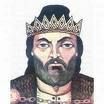
The government gets rid of its own leader, with the Roman LBJ Octavian waiting in the wings, but this time they don't try to coverup the fact that it's a conspiracy or frame a lone gunman? In Jan. 44 B.C.E. popular-with-plebeians Julius Caesar is appointed dictator (imperator) for life at his own request, and twice magnanimously refuses the crown of a king, although he renames the 5th Roman month Quintilis to Julius (July) as he were, performing all kinds of questionable actions to boot; but like true Italians, the aristocrats don't get mad, they get even with anybody even within a Roman mile of becoming a king, so on Mar. 15 (Wed.) (the Ides of March) (a.m.) after ignoring the entrail-examining Haruspices, soothsayer Spurrina ("Beware the Ides of March"), and his own wife Calpurnia Pisonis (b. -75) (who dreamed of their house collapsing, or, according to Shakespeare, of a statue of him streaming with blood while smiling men bathed their hands in it), plus a note pressed into his hand in the street on his way to the Senate (that reads "Beware of Brutus, take heed of Cassius, come not near Casca" according to Shakespeare) by defecting conspirator Artemidorus (which he is too busy to read), 55-y.-o. Gaius Julius (Gr. "child of Jove") Caesar (Lat. "hairy") (b. -100) is assassinated (after stupidly arriving unarmed and without bodyguards, trusting to luck, goodwill of the people, fate, whatever, and setting a precedent for future suicidal U.S. presidents like Lincoln and JFK?) as he sits in his gilded chair at the head of the Senate Curia (Hall of Pompey) at the foot of a giant statue of his late arch-rival Pompey (poetic justice?) by a group of 60 senators concealing daggers in their togas, who all approach at the same time, with Lucius Tullius Cimber (d. -42) asking him to pardon his exiled brother and being refused, then grabbing his purple robe from his shoulders, causing Caesar to shout "Why, this is violence!", after which the first blow is struck by Publius Servilius Casca Longus (-84 to -42) (who is standing behind him) in the back of the neck (Plutarch) or breast (Appian), which doesn't hurt him very badly, allowing old soldier Caesar to catch him by the arm, crying "Casca, you villain, what are you doing?", as he runs his arm through with his writing stylus, causing him to cry to his brother Gaius Casca in Greek "Help, brother!", after which the others, incl. Gaius Cassius Longinus (-86 to -42), Caesar's good friend Marcus Junius Brutus the Younger (-85 to -42), Caesar's Massilian naval cmdr. Decimus Junius Brutus Albinus (-85 to -43), and poet Gaius Cassius Parmensis (-74 to -30) (from Parma) close in and beginning stabbing Caesar before he can leap to his feet, instead hiding his head in his robe so nobody can see his face and using his left hand to hold his toga as he falls, ultimately receiving 23 dagger holes in his toga, groaning only at the first stroke, although he might have (should have?) uttered the immortal soundbyte "Et Tu, Brute?" ("You too, Brutus?") (really "Tu quoque, fili me?", meaning "You too, my son?) (really the Greek phrase "Kai su, teknon?", meaning "You too, my child?) to Marcus or Decimus Brutus (who are from the #1 bluebood line of Rome, descending from big 509 B.C.E. hero Junius Brutus, who led the overthrow of the the Etruscan kings and started independent Rome going, meaning that if he's in it they're all in it) (or maybe the first words of the well-known Greek saying "You too, my son, will have your taste of power", meaning he will end up the same way?), who stabs him in the groin and is wounded by another senator's dagger in the flurry of stabbing; meanwhile Gaius Trebonius (-92 to -43) (appointed suffect counsul by Caesar in -45, and proconsul of Asia this year) keeps Marc Antony busy outside the Senate while the dirty work is going on; after the assassins exunt stage right, three slaves carry him home on a litter with one arm hanging out, after which physician Antistius conducts the first known forensic homicide investigation and (after counting the dagger holes, coming out 23 just like Jim Carrey (1962-) told ya?) concludes that only one (the 2nd?) stroke (to the breast) was mortal; 1,643 years later (1599 C.E.) William Shakespeare writes the immortal play Julius Caesar, dramatizing the event, incl. the soothsayer, wife Calpurnia's dreams, his own big mouth ("The omens shall be what Caesar makes them be") ("Et tu, Brute?"), etc.; on Mar. 17 the Roman Senate meets, and Marc Antony surprises the backstabbers by not demanding their arrest, but agrees to let them go unpunished if they approve Caesar's will and allow him a proper public funeral, and after they bite he tries some real speechifying, reading Caesar's will on Mar. 20 to the crowd in the Forum, going on about how his gardens along the Tiber River are to be turned into a public park, every Roman citizen is to be given 300 sesterces ($15), and what a great guy this stabbed-in-the-back man of the people was, expertly fanning the crowd into a frenzy, shouting for the assassins' blood (get em', boys?), causing them to cremate the body on an improvised pyre, then begin the 13-year Post-Caesarian (Liberators') Roman Civil War (ends -30); after Caesar's aristocratic murderers come to bad ends as the People with a capital P bring them down, future aristocrats get smart and begin using puppet murderers so they can hide behind the curtains and cut the strings when the People begin to investigate; too bad, Antony's hopes of being adopted by Caesar and becoming the next king are shattered when he reads the rest of the will, which names Caesar's 18-y.-o. grandnephew Octavian (Gaius Octavius Thurinus) (-63 to 14) as his adopted son and sole heir Gaius Julius Caesar Octavianus (that covers all eight octaves?), and in early Apr. after his mommy Atia Balba Caesonia (-85 to -43) and adoptive daddy (hubby since -59) Lucius Marcius Philippus (d. -43) (lifelong fence-sitter, who sat out the war between Caesar and Pompey) fail to talk him out of it, the lucky devil returns from Apollonia in Dalmatia to Rome to take up his inheritance, starting out on the wrong foot on Apr. 18-21 by offending Cicero (who is orating against Antony) by trying to charm the fat pompous ass, and in June Antony is granted a 5-year governorship of N-C Cisalpine and Transalpine Gaul, spending Caesar's fortune instead of giving it to the people like he promised in his funeral speech, and marching N to claim his province of Cisalpine Gaul, allowing Octavian to sells his own possessions to pay them himself and play the hero, causing many legions to switch allegiance to him; meanwhile Brutus and Cassius flee to raise an army in the east, and Cassius captures Dolabella in Laodicea, Syria; Cleopatra VII flees to Alexandria, has her brother-consort Ptolemy XIV asp-assinated (poisoned) on July 26, and on Sept. 2 declares her 4-y.-o. son Caesarion as her co-regent Ptolemy XV Caesarion, king #16 (last) of the Egyptian 32nd (Ptolemaic) Dynasty; too bad, this year Egypt has the first in a series of bad harvests.
In summer 43 B.C.E. Cleopatra VII gains control of Cyprus, and backs the Second Triumvirate against the assassin party of Brutus and Cassius.
In winter 43 B.C.E. a volanic eruption in Okmok Island in the Aleutian Islands causes the Nile River to fail to flood this year and next, causing famine in Egypt.

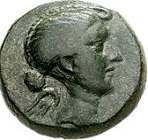
In 41 B.C.E. Cleopatra is invited by Roman big dick Marc Antony (Marcus Antonius) (-83 to -30) to meet in Tarsus, and she puts on a royal show that turns him on, "sailing up the river in a barge with a gilded hull and outspread sails of purple, while oars of silver beat time to the music of flutes and fifes [6-hole?] and harps. She herself lay under a canopy of gold, dressed like Venus, and beautiful children, like painted Cupids, stood on each side to fan her. Her maids were dressed as sea nymphs. Some of them stood steering at the rudder and others worked the sail-ropes while the sweet scent of perfumes drifted from the boat to the shore" (Plutarch); they become lovers and return to Alexandria together where they galavant about drunk with love, Antony letting his army go to pot so he can walk like an Egyptian with perfumed poon, babbling about needing Egypt in his war with Parthia and returning the old Ptolemaic territories to her.
On Dec. 25, 40 B.C.E. Cleopatra VII has boy-girl twins by Marc Antony, Cleopatra Selene II (Cleopatra VIII) (-40 to -6) and Alexander Helios (-40 to -25).
In 38 B.C.E. Antony gives parts of Cilicia and Chalcis to Cleopatra VII, and lets her govern as vassal parts of Phoenicia, Judaea, Cyrenaica and Crete, maintaining cordial relations with Herod I the Great.
In 37 B.C.E. Marc Antony fights several expensive battles in Asia, and thinks with his head and settles in Alexandria, telling wife Octavia to go back to Rome; he then campaigns against the Parthians, and is saved from falling in battle by the Third Gallica Legion, causing him to make it his main legion; meanwhile Octavian engineers the Second Pact (Treaty) of Tarentum, signed by him, Antony, and Lepidus, renewing the Second Triumvirate for five more years (until -33), while ceding Sicily, Sardinia, and Corsica to Sextus Pompey.

In 36 B.C.E. Octavian's fleet under Marcus Vipsanius Agrippa (-63 to -12) defeats rebel Sextus Pompey at the naval Battle of Mylae and the naval Battle of Naulochus (Sept. 3) in Sicily, cementing Octavian's rule over the Roman Empire; Sextus Pompey flees to Greece, where he is executed; Lepidus half-heartedly supports Octavian, then attempts to take over Sicily, is deserted by his troops, kicked out of the Triumvirate and kept in luxurious captivity in Rome until his death; the new troops double Octavian's legions to 22; Octavian and Antony split Roman territory between them east-west, and Antony invades Parthia, but bogs down and fails to take Phraapsa (capital of Media Atropatene), then retreats to Egypt, losing 22K men in his retreat through Armenia, then rejects Octavia's offer of aid in favor of his main squeeze Cleopatra VII, who gives him a 3rd child, marrying her even though still married to Octavia - I tell my wife I love her but she never believes me 'cause she doesn't love herself?
In 34 B.C.E. Octavian pacifies Dalmatia, Illyricum, and Pannonia, founding the town of Emona (modern-day Lyublyana) on the Sava River; meanwhile his rival Marc Antony conquers Armenia, expels the Parthians from Syria and Palestine and celebrates a triumph in Alexandria with Cleopatra VII, where Cleo Baby is called "the New Isis" and "Queen of Kings"; in the fall the Donations of Alexandria are pub., naming his children by Cleopatra, Alexander Helios (-40 to -29), Cleopatra Selene II (Cleopatra VIII) (-40 to -6), and Ptolemy Philadelphus (-36 to -29) as kings and queens with various eastern Roman territories distributed to them, and declaring Octavian a usurper of the rightful heir Caesarion, while visions of a new world order dance in their heads; Marc Antony sets Cleopatra VII up as pharaoh of Egypt - they're playing our song?
In 33 B.C.E. 8-y.-o. Alexander Helios, son of Marc Antony and Cleopatra, and pretender to the thrones of Armenia, Media, and Parthia marries Princess Iotapa, daughter of Median king Artavasdes I - your baby is how old, two?
Introducing Alexandria Hydrocolor lipstick from Olive Garden? In 32 B.C.E. the Triumvirate runs out again and is not renewed; in July after Antony divorces Octavia for Cleo you know who, stirring anti-Egyptian feelings, the Roman Senate declares war on Marc Antony and Cleopatra VII, and Octavian turns the Antonian consuls and 300 senators to him, then gets the West to swear an oath of allegiance to him as dux (military leader), publishing Antony's alleged will bequeathing the East to Cleopatra to cement their loyalty - the Western world is in the balance because of a skirt?
On Sept. 2, 31 B.C.E. after Octavian is elected consul and declares war against Cleopatra, Octavian's admiral Marcus Vipsanius Agrippa defeats Antony and Cleopatra VII at the naval Battle of Aspium, er, Battle of Actium, a promontory in NW Greece in the Ionian Sea; each side has 500 war ships and 40K legionaries, but Antony's soldiers believe he has been bewitched (pussy-whipped?) and many refuse to fight; Antony's ally Herod the Great claims he can't help him because he has to keep the Nabateans in check; Cleopatra breaks through a line of Octavian's ships to avoid capture (thinking Antony is dead?), and Antony thinks with his head (nose?) and runs after her, leaving most of his fleet behind, insuring a big D, after which Herod sticks to his dental plan called avoidance and goes to Rhodes to offer his loyalty to Octavian, becoming his close brown-nosing friend; the D is really a tactical V since it allows Antony and Cleo to break out of an isolated position at Actium?; either way, Octavian now controls the East.

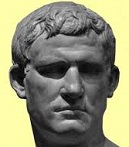




16 big game days, 2 superheroes, one very special family room? In summer 30 B.C.E. Julius Caesar's chosen heir Octavian (Gaius Octavius) (-63 to 14) marches his armies around the Aegean, through Asia Minor and into Egypt; in July Marc Antony (b. -83) defends Alexandria from Octavian's Gen. Marcus Agrippa (-63 to -12), but his men desert, he is told that Cleopatra is dead, and falls on his own sword; on Aug. 1 Octavian captures Alexandria, and annexes Egypt as the Roman Province of Egypt (ends 641 C.E.); the Roman V gives them direct access to the Malabar Coast in India, allowing them to begin importing precious black pepper; on Aug. 12 aging 39-y.-o. Cleopatra VII (b. -69), after trying unsuccessfully to pussy-whip Octavian and negotiate to keep her Ptolemaic kingdom intact and keep her kids, only to learn that she is to be brought to Rome in chains as a common POW commits suicide at age 39 in Alexandria with an asp (Egyptian cobra) in a fig basket, becoming Egypt's last pharaoh; Shakespeare never calls it an asp, preferring the word "worm"; "Poor venomous fool, be angry, and dispatch" (William Shakespeare, Antony and Cleopatra, Act 5 Scene 2); "And Agrippa asked, 'Was this well done of your lady?', and the servant answered 'Extremely well, as befitting the last of so many noble rulers'" (1963 film Cleopatra) - don't have to live like a refugee? no one is predictable, not even a huckster? No one is predictable, not even a huckster? In Aug. teen prom queen Ptolemy XV Caesarion (b. -47) is strangled, ending the last dynasty of ancient Egypt, the Ptolemaic Dynasty (began -305); Augustus orders the doors of the Temple of Janus closed for the 1st time since -235, indicating that Rome is finally at peace; the rest of Cleopatra's children are raised certified organic by Octavia; so much Egyptian loot fills Roman coffers that interest rates slide from 12% to 3%, increasing Octavian's popularity; up to 50 obelisks are shipped to Rome in huge specially-designed ships; Rome begins surpassing Egypt in intellectual supremacy?
In the 1st cent. C.E. the Periplus of the Erythraean (Eritrean) Sea is written, describing sailing routes from Egypt through the Red Sea along NE Africa, plus SW India and the Sindh of Pakistan. In the 1st cent. C.E. an Egyptian papyrus containing wisdom texts is written, revealing that the goddess Isis gave as much power and honor to women as to men, permitting them to own property, practice professions include medicine, and serve as witnesses, plaintiffs, and defendants in court.
In the 8th cent. C.E. Alexandria, Egypt sinks beneath the Mediterranean Sea in Aboukir Bay; rediscovered in 1933.
In 1880 after the Egyptian govt. gives it as a gift, Cleopatra's Needle arrives in New York City to a big celebration, with 9K Freemasons parading on Fifth Ave. with the pedestal, while the 69-ft. 220-ton shaft is dragged across Manhattan from the banks of the Hudson River for 112 days and installed W of the new Metropolitan Museum of Art.
On June 11, 2017 Johannes Krause et al. of the Max Planck Inst. pub. a study in Nature Communications, using DNA from mummies to determine that ancient Egyptians were white not black, most closely related to the peoples of the Levant (E Mediterranean), with far less than the modern value of 8% of their genome shared with central Africans.